Dog Food Ingredient Glossary
|
Meatsand animal products
|
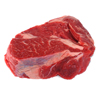
|
Beef

|
Good quality ingredient with beneficial nutrients
|
|
In pet food, beef can be used as a fresh meat (fresh beef, deboned beef, freshly prepared beef) or as a pre-prepared, dry meat meal (beef meal, dried beef, dehydrated beef). When the ingredient is listed simply as 'beef' it usually refers to the fresh form.
Although the quality of beef used in pet foods can vary, it is generally regarded as a highly digestible, highly palatable meat source for dogs. In the past, some pet food manufacturers had labelled beef as a problematic meat for dogs but solid evidence is hard to come by.
Red meats like beef do, however, contain higher levels of cholesterol which should be kept to a minimum if your dog has a history of health problems. Red meats also contain higher levels of purines and other minerals (especially in the 'meal' form due to the higher bone content) which are best avoided in dogs with urinary conditions.
Find foods containing Beef
Go back to top
|
|
|
Bone meal

|
Medium quality ingredient - nutritionally adequate and unlikely to cause any problems e.g. fillers etc
|
|
Bone meal or ground bone is added to some dog foods as a natural calcium and phosphorous supplement. Its definition is very vague as it could come from any animal so if your dog is intolerant to a specific meat, bone meal is probably best avoided.
Find foods containing Bone meal
Go back to top
|
|
|

|
Chicken

|
Good quality ingredient with beneficial nutrients
|
|
In pet food, chicken can be used as a fresh meat (fresh chicken, deboned chicken, freshly prepared chicken) or as a pre-prepared, dry meat meal (chicken meal, dried chicken, dehydrated chicken). When the ingredient is listed simply as 'chicken' it usually refers to the fresh form.
Chicken is the most popular meat found in dog foods. It is highly palatable, relatively inexpensive and provides an excellent source of protein. For most dogs, chicken is very easy to digest but its widespread usage in dog foods has lead to a higher rate of intolerance to chicken than to any other meat so if your dog is particularly prone to dietary intolerance, chicken may not be the best choice.
As with all meats, the quality of the chicken used in pet foods can vary considerably so for more details on the chicken found in your dog's food, please contact the manufacturer directly.
Find foods containing Chicken
Go back to top
|
|
|
Colostrum

|
Medium quality ingredient - nutritionally adequate and unlikely to cause any problems e.g. fillers etc
|
|
Colostrum is the form of milk produced by the mammary glands of all mammals around the time of birthing. In order to start the baby off on the right foot, colostrum is rich in antibodies, vitamins, minerals and amino acids. It is widely regarded as a very healthy supplement for both humans and animals. Colostrum for pets is harvested from dairy cattle.
Although colostrum is lower in lactose than normal milk, it nevertheless contains some and should therefore be avoided if your dog is dairy intolerant.
Find foods containing Colostrum
Go back to top
|
|
|
Dairy products

|
Inferior or controversial ingredient
|
|
Although milk contains several beneficial nutrients, it also contains a high proportion of the sugar lactose. As in humans, many dogs have real difficulties digesting lactose and as a result milk products can bring on stomach pains, flatulence, diarrhoea and even vomiting. This condition is known as lactose intolerance. Lactose is also present in virtually all dairy products including cheese, yogurt, cream, whey and ice cream. If your dog has a sensitive stomach, dairy products are generally best avoided.
Find foods containing Dairy products
Go back to top
|
|
|
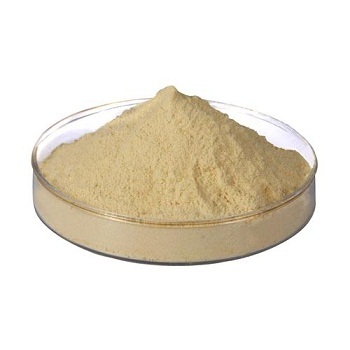
|
Digest / Hydrolysed Animal Proteins

|
Good quality ingredient with beneficial nutrients
|
|
Proteins are formed from long chains of amino acids. By using enzymes and/or acids to perform a process called hydrolysis, these chains can be broken down into their constituent parts. The resulting substance, now called protein hydrolysate, hydrolysed proteins or simply digest, is then spray dried to form a powder which can be useful in pet food for a number of reasons.
The first and most common use is as a flavour enhancer since the hydrolysed proteins tend to taste and smell very attractive to dogs.
Second, while certain whole proteins might trigger allergic responses in some dogs, the much smaller molecules of protein hydrolysate go completely undetected by the immune system making them ideal for dogs that are highly prone to allergies.
And last, protein hydrolysate provides a useful source of relatively inexpensive but bio-appropriate amino acids.
Most often, protein hydrolysate is formed from 'slaughterhouse side streams', that is castoffs from the meat industry that, while not particularly appetising to you and me, serve perfectly well as a basis for hydrolysis. But some companies go much further using higher end meat ingredients or even whole animals for their protein hydrolysate.
Although protein hydrolysate is undoubtably useful, it has attracted criticism, especially from some natural feeding advocates who claim that the acidic/enzymatic reactions that are used to make it aren't really 'natural'. Another cause for concern for some lies in the fact that monosodium glutamate (MSG) can be formed during the hydrolytic breakdown of proteins. MSG is a very effective flavour enhancer which may cause dogs (and humans) to eat much more than is healthy and thus contribute to the growing pet obesity epidemic. When MSG is added to foods as part of a protein hydrolysate, it does not need to be declared on the label.
As with all meat ingredients, it's always better to make sure the animal species is specified. This means ingredients like 'chicken liver digest' or 'fish hydrolysate' are much better than simply 'digest' or 'meat hydrolysate'.
Find foods containing Digest / Hydrolysed Animal Proteins
Go back to top
|
|
|
Duck

|
Good quality ingredient with beneficial nutrients
|
|
In pet food, duck can be used as a fresh meat (fresh duck, deboned duck, freshly prepared duck) or as a pre-prepared, dry meat meal (duck meal, dried duck, dehydrated duck). When the ingredient is listed simply as 'duck' it usually refers to the fresh form.
Duck meat is a good source of high quality protein. It is easy for dogs to digest and also scores well in taste tests. Duck meat is also a good source of vitamin A and B3 as well as several minerals.
As with all meats, the quality of the duck used in pet foods can vary considerably so for more details on the duck found in your dog's food, please contact the manufacturer directly.
Find foods containing Duck
Go back to top
|
|
|
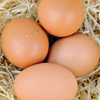
|
Egg

|
Good quality ingredient with beneficial nutrients
|
|
Eggs are a good source of low-cost, high-quality protein, fat and various minerals and micronutrients. Some of the fat is however cholesterol which should be kept to a minimum if your dog has high blood pressure or a history of heart problems.
Find foods containing Egg
Go back to top
|
|
|
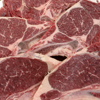
|
Fresh Meat

|
Good quality ingredient with beneficial nutrients
|
|
'Fresh meat' is a highly nutritious and palatable protein source for dogs. It usually consists of animal viscera (the internal organs and connective tissues) which is left over from the processing of human-grade animals. Despite not being exactly what most people have in mind when they think of fresh meat, it remains a high quality ingredient and is, after all, a very natural food for dogs.
Fresh meat is widely used in wet dog foods and is also becoming increasing popular in dry foods. When comparing the meat contents of dry foods it is important to remember that since fresh meat contains roughly 70% water (compared to just 5-7% in meat meal) it is far less nutritionally concentrated than meal and so more is required. For example, in order to provide the same levels of protein and fat as 20% meat meal a dry food would need 72% fresh meat!
Find foods containing Fresh Meat
Go back to top
|
|
|
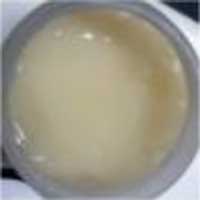
|
Freshly Prepared Meat

|
Good quality ingredient with beneficial nutrients
|
|
Freshly prepared meat or FPM is a fairly new and very interesting ingredient. Despite it already being used widely in dry pet foods, many manufacturers that use it are reluctant to give too many details on its exact nature which has led to a lot of confusion on the ingredient.
In order to examine Freshly Prepared Meat we must first look at meat meal, which FPM is usually used to replace. Meat meal (or Dry Rendered Meat / DRM) has long been the mainstay of the dry pet food industry but in recent years has fallen from favour somewhat, at least in the super-premium market. This is because:
- Consumers increasingly (and correctly) see it as inferior to real fresh meat.
- It can only be added to foods in relatively small quantities due to its very high concentration of protein and ash. In an age where every premium food wants to boast about the percentage of meat in their foods, this is a considerable drawback.
So dry food manufacturers began looking for alternatives. Fresh meat isn't ideal as the large amount of water it contains (~75%) makes it much harder to form a stable, dry biscuit.
Freshly Prepared Meat, on the other hand, is perfect. It only contains around 60% moisture which is much easier for extruders to handle, it's not as concentrated as meat meal so you can put a much higher proportion into the food and, with some careful marketing, you can make everyone think it's real fresh meat!
But real fresh meat it is not.
What is Freshly Prepared Meat?
Producing Freshly Prepared Meat involves several steps [1]:
- Mechanical separation of the animal carcass through a deboning machine.
A chicken carcass, for example, is a chicken, exclusive of feathers, head, feet and entrails and with the majority of actual meat (muscular tissue) removed for human consumption. It may be frozen.
- Grinding reduces particle size to produce a fine paste.
- Pasteurisation - the application of relatively low levels of heat (usually less than 100°C) for a short amount of time to eliminate pathogens and extend shelf life.
- Separation of water and fat via centrifuge. These can then be added back to the mixture depending on the nutritional specifications of the manufacturer.
- Concentration by low temperature vacuum evaporation.
What you are left with at the end of the five steps is a fairly viscous, beige-coloured 'meat slurry'. This is called 'Freshly Prepared Meat'.
How does Freshly Prepared Meat compare?
FPM has a number of advantages over meat meal [1]:
- It has a higher protein digestibility and availability
- It has a lower oxidised fat content
- It is considerably more palatable to dogs
Unfortunately, no similar comparison has been done between FPM and fresh meat.
How is FPM affected by the extrusion process?
Amazingly, nobody seems to know or at least no one wants to tell me.
One study [1] demonstrated that freeze-dried FPM remains nutritionally superior to meat meal following extrusion but since FPM in extruded food is not freeze-dried, these findings seem pretty irrelevant.
Another study [2][3], however, showed that real fresh meat, once extruded, is no more nutritious than meat meal so while this is likely to also be the case for FPM, it is currently impossible to say.
Why the secrecy
FPM is not a bad ingredient by any stretch but it is not exactly what most people picture when they hear the words 'freshly prepared meat'. For this reason, manufacturers are reluctant to provide too much information about FPM that might shatter your preconceived illusions.
In conclusion
Freshly Prepared Meat is essentially a meat concentrate - a midpoint between fresh meat and meat meal. As an alternative to meat meal it performs very well and provides a number of benefits. It is not, however, real fresh meat and any manufacturer suggesting that it is is arguably misleading their customers.
References
- Low temperature processed meat in extruded dry petfood: 2- Effect of commercial scale processing on nutritional and eating qualities; University of Nottingham, 2015. https://www.atavik.fr/wp-content/uploads/2018/09/pdf-etude-frais-deshydrate-fr-2018-update.pdf. Scroll down on the linked page for the full paper and an accompanying slide show. Apologies for the weird location of the paper but this really is the only place I can find it.
- Protein and amino acid bioavailability of extruded dog food with protein meals of different quality using growing mink (Neovison vison) as a model; Tjernsbekk MT, Tauson AH, Matthiesen Cf, Ahlostrom O. Journal of Animal Science 2016; 94:3796-3804.
- Raw, mechanically separated chicken meat and salmon protein hydrolysate as protein sources in extruded dog food: Effect on protein and amino acid digestibility; Tjernsbekk MT, TAuson AH, Kraugerus OF, Ahlstrom O. Animal Physiology and Animal Nutrition 2017.
Find foods containing Freshly Prepared Meat
Go back to top
|
|
|
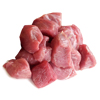
|
Lamb

|
Good quality ingredient with beneficial nutrients
|
|
In pet food, lamb can be used as a fresh meat (fresh lamb, deboned lamb, freshly prepared lamb) or as a pre-prepared, dry meat meal (lamb meal, dried lamb, dehydrated lamb). When the ingredient is listed simply as 'lamb' it usually refers to the fresh form.
Lamb is an excellent meat source for dogs. It is both highly palatable and easily digested. Most of the lamb found in British pet foods comes from the UK (typically Wales) or is imported from countries like New Zealand.
Red meats like lamb do, however, contain higher levels of trans-fats and cholesterol which should be kept to a minimum if your dog has a history of health problems. Red meats also contain higher levels of purines and other minerals (especially in the 'meal' form due to the higher bone content) which are best avoided in dogs with urinary conditions.
As with all meats, the quality of the lamb used in pet foods can vary considerably so for more details on the lamb found in your dog's food, please contact the manufacturer directly.
Find foods containing Lamb
Go back to top
|
|
|
Liver

|
Good quality ingredient with beneficial nutrients
|
|
The nutritional properties of liver do vary from species to species but in general liver is widely recognised as an exceptionally beneficial, nutrient-dense food for dogs. It is rich in vitamin B12, vitamin A, copper, folate, riboflavin, and selenium and contains good levels of zinc, vitamins C, B5 and B6, protein, niacin, phosphorous and iron. It is easily digested and highly palatable.
Find foods containing Liver
Go back to top
|
|
|

|
Meat and Animal Derivatives

|
Particularly low grade, highly contentious or excessively vague ingredient we usually recommend avoiding
|
|
According to European law, 'meat and animal derivatives' is defined as "All the fleshy parts of slaughtered warm-blooded land animals, fresh or preserved by appropriate treatment, and all products and derivatives of the processing of the carcass or parts of the carcass of warm-blooded land animals".
Clearly this is very loose and does not provide any clues as to what parts or even what animals are being used.
It must be said that the presence of this ingredient is not necessarily a bad thing as it encompasses all meats, from the very best, to the very worst. For example, some producers of good foods use broad terms like this in order to not give away their 'secret formula' and some imported foods list very high quality meat as 'meat and animal derivatives' simply because the laws or customs in their home country are different. At the opposite end of the scale, the term can be used for very low-grade animal products including some that are nutritionally very poor. Also, because the species isn't specified, manufacturers are able to change their meat source between batches depending on what is available at the time.
The problem with broad, vague terms like this is that you just don't know. Where you do see it, make sure it states what animal it comes from, and ideally what parts of the animal. If your dog is prone to food intolerance, it is certainly wise to steer away from meat and animal derivatives and all other non-specific ingredients.
Find foods containing Meat and Animal Derivatives
Go back to top
|
|
|
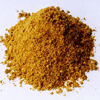
|
Meat Meal

|
Good quality ingredient with beneficial nutrients
|
|
Most people are quite surprised when they first see meat meal. It is a fine, dry, brown powder which, for many years, has formed the backbone of the dry dog food industry around the world. It can be listed in a number of ways, with or without the animal source. For example, meat meal from chicken could be labelled as 'meat meal', 'chicken meal', 'chicken meat meal', 'dehydrated chicken' or 'dried chicken'.
Meat meal is made from the parts of animals that aren't consumed by humans. This could be up to a third to a half of the original animal and generally includes residual meat, offal, connective tissues and in some cases bones. According to UK Feed Stuffs Regulations, meat meal "should be virtually free of hair, bristle, feathers, horn, hoof and skin and of the contents of the stomach and viscera".
The process by which meat meal (and many other animal by-products) are created is called rendering. First the animal raw materials are ground and cooked, usually with steam, for a period of 40 to 90 minutes at temperatures of approximately 115 to 145oC. Moisture is removed and pressure is applied to separate the melted fats from the protein and bone solids. The cooking kills all micro-organisms and parasites. Following the cooking and fat separation, the mix is further processed by additional moisture removal and grinding to form the powder.
How much the rendering process affects the nutritional quality of meat is a matter of some debate but most nutritionists agree that meat meal is unlikely to be quite as nutritionally beneficial for dogs as fresh meat ingredients.
It is, nevertheless, still an excellent source of natural, bio-appropriate amino acids (the building blocks of proteins), fats and certain minerals and vitamins. Furthermore, because meat meal is only around 5-7% water, it is far more concentrated than fresh meat (which contains roughly 70% water) and as a result much less is needed. For example, 20% fresh meat would only equate to around 6.5% meat meal. This is an important consideration when comparing the meat contents of dry dog foods.
If the source animal is not specified, the general term 'meat meal' means that it could have come from any species of 'warm-blooded land animal'. Broad terms like this are often used by dog food manufacturers instead of naming each ingredient either because the recipe regularly changes and/or because naming the ingredients would put customers off.
Antioxidants must be added to meat meal during its production in order to prevent it from becoming rancid. These antioxidants can be natural (such as vitamin E, Vitamin C and rosemary oil) or artificial. In the case of artificial antioxidants, the most commonly used in meat meals are the highly controversial and potentially harmful chemicals BHT, BHA and Propyl gallate.
The main issue here is that, since the antioxidants are added to the meat meal at the meat rendering plant long before it arrives at the dog food factory, the manufacturer does not need to declare them on the label. In fact, a food can contain any number of ingredients that have been pre-treated with artificial additives by the ingredient suppliers and can still legally say that their food has 'no added artificial additives' just as long as they don't add any more themselves! For this reason it's always important to look for foods that are guaranteed 'free from artificial additives' (rather than 'free from added artificial ingredients') or, if you are in any doubt, to ask the manufacturer directly.
Find foods containing Meat Meal
Go back to top
|
|
|
Pork

|
Good quality ingredient with beneficial nutrients
|
|
In pet food, pork can be used as a fresh meat (fresh pork, deboned pork, freshly prepared pork) or as a pre-prepared, dry meat meal (pork meal, dried pork, dehydrated pork). When the ingredient is listed simply as 'pork' it usually refers to the fresh form.
Although pork was once thought of as a problem ingredient for dogs, it is now widely recognised as a good, highly palatable meat source. Nevertheless, it is still rarely found in dog foods making it a 'novel protein' for a lot of dogs. This can make pork-based foods particularly useful for allergy-prone dogs as it is impossible to be allergic to a food that you have never been exposed to.
Pork, like most mammalian meats, does, however, contain higher levels of purines and other minerals (especially in the 'meal' form due to the higher bone content) which are best avoided in dogs with urinary conditions.
Uncooked pork also carries a higher risk of parasitic infection than most meats so it is always best to cook and raw pork thoroughly prior to feeding. Dry, tinned and all other cooked commercial dog foods are always parasite free.
As with all meats, the quality of the pork used in pet foods can vary considerably so for more details on the pork found in your dog's food, please contact the manufacturer directly.
Find foods containing Pork
Go back to top
|
|
|
Poultry

|
Medium quality ingredient - nutritionally adequate and unlikely to cause any problems e.g. fillers etc
|
|
In pet food, poultry can be used as a fresh meat (fresh poultry, deboned poultry, freshly prepared poultry) or as a pre-prepared, dry meat meal (poultry meal, dried poultry, dehydrated poultry). When the ingredient is listed simply as 'poultry' it usually refers to the fresh form.
As a food group, poultry provides a good quality, relatively low-cost source of highly palatable protein. The category includes products from any domestic fowl such as chicken, turkey or duck.
Since the term 'poultry' doesn't specify which animal species the meat comes from, it is frowned upon by many canine nutritionists. Ambiguous terms like poultry allow the manufacturer to change the recipe from batch to batch and make it very difficult to identify problem foods with dogs that are prone to dietary intolerance.
As with all meats, the quality of the poultry used in pet foods can vary considerably so for more details on the poultry found in your dog's food, please contact the manufacturer directly.
Find foods containing Poultry
Go back to top
|
|
|
Poultry Fat

|
Medium quality ingredient - nutritionally adequate and unlikely to cause any problems e.g. fillers etc
|
|
Dogs, like all animals, need fats to survive and as carnivores, they are best suited to animal fats.
In general, animal fats are produced as a by-product of meat meal production. When the meat is heated and ground, the fats melt and are drained away. The resulting dry meat meal powder is therefore relatively low in fat so most dog foods that use meat meal have added fat to bring the levels back up.
Dogs also really like the taste of fat so it is tempting for manufacturers to add a little more than is strictly needed to make their foods that little bit more appealing. Unfortunately, as we all know, too much fat can cause all sorts of problems so if you notice your dog is starting to put on a little too much weight, you may want to consider a food with a lower fat content.
Although not as bad as the general term 'animal fats', 'poultry fat' does still leave some ambiguity as it could refer to any fat from any foul species including chickens, turkeys and ducks. This allows the manufacturer to alter the recipe between batches depending on what fats are cheaper at the time. As always, we recommend looking for foods where the sources of the fats and oils are clearly stated.
Find foods containing Poultry Fat
Go back to top
|
|
|

|
Rabbit

|
Good quality ingredient with beneficial nutrients
|
|
In pet food, rabbit can be used as a fresh meat (fresh rabbit, deboned rabbit, freshly prepared rabbit) or as a pre-prepared, dry meat meal (rabbit meal, dried rabbit, dehydrated rabbit). When the ingredient is listed simply as 'rabbit' it usually refers to the fresh form.
Although, like all meats, the quality of rabbit used in pet foods can vary, it is generally regarded as an excellent meat source for dogs. It is a great source of protein, it is highly digestible and it is completely bio-appropriate - i.e. it closely resembles the natural diet of the dog.
Rabbit meat is used fairly rarely in dog foods making it a 'novel protein' for a lot of dogs. This can make rabbit-based foods particularly useful for allergy-prone dogs as it is impossible to be allergic to a food that you have never been exposed to.
The rabbits used in pet food can be farmed or caught from the wild.
Find foods containing Rabbit
Go back to top
|
|
|
Specified Animal Fats and Oils

|
Good quality ingredient with beneficial nutrients
|
|
Dogs, like all animals, need fats to survive and as carnivores, they are best suited to animal fats. Specified animal fats (ones where the animal species is named - for example, chicken fat, duck oil etc.) are particularly good as they ensure the recipe remains the same from batch to batch.
In general, animal fats are produced as a by-product of meat meal production. When the meat is heated and ground, the fats melt and are drained away. The resulting dry meat meal powder is therefore relatively low in fat so most dog foods that use meat meal have added fat to bring the levels back up.
Dogs also really like the taste of fat so it is tempting for manufacturers to add a little more than is strictly needed to make their foods that little bit more appealing. Unfortunately, as we all know, too much fat can cause all sorts of problems so if you notice your dog is starting to put on a little too much weight, you may want to consider a food with a lower fat content.
Find foods containing Specified Animal Fats and Oils
Go back to top
|
|
|
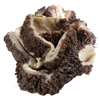
|
Tripe

|
Good quality ingredient with beneficial nutrients
|
|
In pet food, tripe can be used in its fresh form (fresh tripe, freshly prepared tripe) or as pre-prepared dry meal (tripe meal, dried tripe, dehydrated tripe). When the ingredient is listed simply as 'tripe' it usually refers to the fresh form.
Tripe is the stomach of ruminating animals - usually from cows but also from sheep, goats, pigs and deer. It is highly nutritious and easy for dogs to digest. Tripe is rich in protein and fat and is a good source of essential oils.
'Green tripe' is tripe that has not been cleaned, bleached or otherwise processed. Green tripe is unique because it contains high levels of probiotics including friendly bacteria and digestive enzymes that can enormously benefit a dog's digestion.
As with all meats, the quality of the tripe used in pet foods can vary considerably so for more details on the tripe found in your dog's food, please contact the manufacturer directly.
Find foods containing Tripe
Go back to top
|
|
|
Turkey

|
Good quality ingredient with beneficial nutrients
|
|
In pet food, turkey can be used as a fresh meat (fresh turkey, deboned turkey, freshly prepared turkey) or as a pre-prepared, dry meat meal (turkey meal, dried turkey, dehydrated turkey). When the ingredient is listed simply as 'turkey' it usually refers to the fresh form.
Turkey meat is easy to digest, highly palatable and provides an excellent source of protein. It is lower in calories and fat than chicken and is therefore often used in light and senior diets.
As with all meats, the quality of the turkey used in pet foods can vary considerably so for more details on the turkey found in your dog's food, please contact the manufacturer directly.
Find foods containing Turkey
Go back to top
|
|
|

|
Unspecified Animal Fats and Oils

|
Inferior or controversial ingredient
|
|
Dogs, like all animals, need fats to survive and as carnivores, they are best suited to animal fats.
In general, animal fats are produced as a by-product of meat meal production. When the meat is heated and ground, the fats melt and are drained away. The resulting dry meat meal powder is therefore relatively low in fat so most dog foods that use meat meal have added fat to bring the levels back up.
Dogs also really like the taste of fat so it is tempting for manufacturers to add a little more than is strictly needed to make their foods that little bit more appealing. Unfortunately, as we all know, too much fat can cause all sorts of problems so if you notice your dog is starting to put on a little too much weight, you may want to consider a food with a lower fat content.
The problem with ambiguous terms like 'animal fats' or 'animal oils' is that they could refer to literally any fat of any quality from any animal. This allows the manufacturer to alter the recipe between batches depending on what fats are cheaper at the time. As always, we recommend looking for foods where the sources of the fats and oils are clearly stated.
Find foods containing Unspecified Animal Fats and Oils
Go back to top
|
|
|
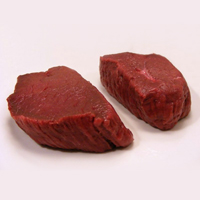
|
Venison

|
Good quality ingredient with beneficial nutrients
|
|
In pet food, venison can be used as a fresh meat (fresh venison, deboned venison, freshly prepared venison) or as a pre-prepared, dry meat meal (venison meal, dried venison, dehydrated venison). When the ingredient is listed simply as 'venison' it usually refers to the fresh form.
Venison is the general term for deer meat. Most of the venison that is used in European pet foods comes from New Zealand but due to a global shortage, the price of venison has shot up over the last few years making it one of the most expensive meat options found in dog foods.
Although the quality of venison used in pet foods can vary, it is generally regarded as a highly digestible, highly palatable meat source for dogs and unlike most meats, venison provides a good source of B vitamins.
Red meats like venison do however contain higher levels of trans-fats and cholesterol which should be kept to a minimum if your dog has a history of health problems. Red meats also contain higher levels of purines and other minerals (especially in the 'meal' form due to the higher bone content) which are best avoided in dogs with urinary conditions.
Find foods containing Venison
Go back to top
|
|
|
Fish & shellfishand their products
|
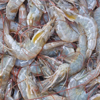
|
Crustaceans

|
Good quality ingredient with beneficial nutrients
|
|
Crustaceans (shrimps, crabs etc) are the most popular source of the joint supplement glucosamine due to the very high concentration found in their shells. They are sometimes added directly to dog foods, in which case they are labelled simply as 'crustaceans' or the glucosamine can be extracted through hydrolysis in which case it will appear on the label as 'glucosamine', 'glucosamine sulphate' or 'hydrolysed crustaceans'.
Find foods containing Crustaceans
Go back to top
|
|
|

|
Fish and fish derivatives

|
Particularly low grade, highly contentious or excessively vague ingredient we usually recommend avoiding
|
|
The EC defines 'fish and fish derivatives' as "Fish or parts of fish, fresh or preserved by appropriate treatment, and derivatives from the processing thereof".
Although broad terms like this attract a lot of criticism, it must be noted that they do not necessarily indicate the presence of low grade ingredients. Fish and fish derivatives for example encompasses all fish products, from the very best to the very worst. For example, some producers of good foods use broad terms in order to not give away their 'secret formula' and some imported foods list very high quality fish as 'fish and fish derivatives' simply because the laws or customs in their home country are different. At the opposite end of the scale, the term can be used for very low-grade fish derivatives including some that are nutritionally very poor. Also, because the type of fish isn't specified, manufacturers using this term are able to change their fish source between batches depending on what is available at the time.
Because it is impossible to know what this refers to, we would suggest assuming the worst and avoiding foods with this ingredient. This is particularly important if your dog is prone to dietary intolerance as identifying and eliminating problem ingredients is impossible unless you know exactly what you are feeding.
Find foods containing Fish and fish derivatives
Go back to top
|
|
|
Fish Meal

|
Good quality ingredient with beneficial nutrients
|
|
Fish meal is a fine, dry powder formed by rendering and grinding both whole fish and the bones and offal from processed fish. It can be listed in a number of ways, with or without the fish species used. For example, meat meal from cod could be called 'fish meal', 'ocean fish meal', 'white fish meal', 'cod meal', 'dehydrated cod' or 'dried cod'. Fish meal usually carries a strong smell which dogs love but some dog owners dislike.
How much the rendering process affects the nutritional quality of the fish is a matter of some debate but most nutritionists agree that fish meal is unlikely to be quite as nutritionally beneficial for dogs as fresh fish ingredients.
It is, nevertheless, still an excellent source of natural, bio-appropriate amino acids (the building blocks of proteins), fats and certain minerals and vitamins. Furthermore, because fish meal is only around 5-7% water, it is far more concentrated than fresh fish (which contains roughly 70% water) and as a result much less is needed. For example, 20% fresh fish would only equate to around 6.5% fish meal. This is an important consideration when comparing the meat contents of dry dog foods. Fish meal from oily fish (as opposed to whitefish) also contains abundant fish oils including several omega-3 and omega-6 oils.
If the species of fish is not specified, the general term 'fish meal' means that it could have come from any combination of fish species. Broad terms like this are often used by dog food manufacturers instead of naming each ingredient either because the recipe regularly changes and/or because naming the ingredients might not be as appealing for the customer.
Antioxidants must be added to fish meal during its production in order to prevent it from becoming rancid. These antioxidants can be natural (such as vitamin E, Vitamin C and rosemary oil) or artificial. In the case of artificial antioxidants, the most commonly used in fish meals are the highly controversial and potentially harmful chemicals BHT, BHA and Propyl gallate.
The main issue here is that, since the antioxidants are added to the fish meal at the fish rendering plant long before it arrives at the dog food factory, the manufacturer does not need to declare them on the label. In fact, a food can contain any number of ingredients that have been pre-treated with artificial additives by the ingredient suppliers and can still legally say that their food has 'no added artificial additives' just as long as they don't add any more themselves! For this reason it's always important to look for foods that are guaranteed 'free from artificial additives' (rather than 'free from added artificial ingredients') or, if you are in any doubt, to ask the manufacturer directly. pollock
Find foods containing Fish Meal
Go back to top
|
|
|
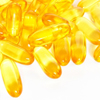
|
Fish Oil

|
Good quality ingredient with beneficial nutrients
|
|
Fish oil comes from the processing of oily fish like tuna, sardines, salmon and mackerel. As well as providing energy, fish oil contains abundant essential omega-3 and omega-6 oils which have wide ranging health benefits. Fish oils are have been recommended for the prevention and treatment of a whole host of health conditions including joint problems, skin conditions, cardiovascular disease and even cancer. Fish oil is also rich in several vitamins including vitamins A, B3 and D.
Find foods containing Fish Oil
Go back to top
|
|
|
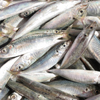
|
Fresh Fish

|
Good quality ingredient with beneficial nutrients
|
|
'Fresh fish' is a highly nutritious and palatable protein source for dogs. It can be made of any parts of any fish but usually consists of the leftovers from human-grade fish, such as viscera, which is minced into a fine paste before being added to the food. All fish, but particularly oily fish like tuna, mackerel, herring and salmon, contains fish oils, which is high in health promoting omega-3 essential oils.
Fresh fish is widely used in wet dog foods and is also becoming increasing popular in dry foods. When comparing the fish contents of dry foods it is important to remember that since fresh fish contains roughly 70% water (compared to just 8% in fish meal) it is far less nutritionally concentrated than meal and so more is required. For example, in order to provide the same levels of protein and fat as 20% fish meal a dry food would need 72% fresh fish!
Find foods containing Fresh Fish
Go back to top
|
|
|
Green-Lipped Mussel

|
Good quality ingredient with beneficial nutrients
|
|
Green lipped mussels contain a wide range of nutrients but their rare combination of omega-3 oils are what they are famous for. These oils, usually called green-lipped mussel extract, are widely recognised as having an anti-inflammatory effect and are often recommended as a source of natural pain relief for arthritis sufferers.
Find foods containing Green-Lipped Mussel
Go back to top
|
|
|
Grains
|
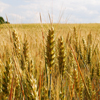
|
Barley

|
Medium quality ingredient - nutritionally adequate and unlikely to cause any problems e.g. fillers etc
|
|
Barley is commonly used in dog food in a variety of forms. Once cooked it is easily digested by dogs and provides abundant fibre and several micronutrients including selenium and copper. Whole grain barley is the best form as it retains most of its nutrients.
In humans, barley gluten has been indicated as a problem ingredient for celiacs so if you are looking for a gluten free food, it would probably be best to steer clear of barley as well as wheat.
Find foods containing Barley
Go back to top
|
|
|

|
Cereals

|
Particularly low grade, highly contentious or excessively vague ingredient we usually recommend avoiding
|
|
The general terms 'cereals' and 'grains' can refer to any product of any cereal including wheat, rice, oats, barley, maize etc.
Although the term 'cereals' attracts a lot of criticism, it must be noted that it does not necessarily indicate the presence of low grade ingredients as it encompasses all grains, from the best to the very worst. For example, some producers of good foods use broad terms like this in order to not give away their 'secret formula' and some imported foods list very high quality grains as 'cereals' simply because the laws or customs in their home country are different. At the opposite end of the scale, the term can be used for very low-grade grain products including some that are nutritionally very poor and others that have been linked to dietary intolerance. Also, because the type of cereal isn't specified, manufacturers are able to change their grain source between batches depending on what is available at the time.
Because it is impossible to know what 'cereals' refers to, we would suggest assuming the worst and avoiding foods with this ingredient. This is particularly important if your dog is prone to dietary intolerance as identifying and eliminating problem ingredients is impossible unless you know exactly what you are feeding.
Find foods containing Cereals
Go back to top
|
|
|
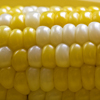
|
Maize / Corn

|
Inferior or controversial ingredient
|
|
Maize (or corn to us Brits) is widely used in dry dog foods as an alternative to grains like rice, oats and barley. Of all of the grains used in dog food, maize is certainly amongst the most controversial, with vocal critics and supporters in equal measure.
It has to be said though that many of the most ardent supporters of maize are from within the pet food industry. They correctly argue that maize is a good quality, nutritious carbohydrate source with a comparable nutritional profile to grains like oats and barley.
Critics of maize, on the other hand, claim that it is harder for dogs to digest and is therefore much more likely to lead to food intolerance or allergies. Many canine nutritionists and some vets now recommend avoiding maize based diets altogether.
Find foods containing Maize / Corn
Go back to top
|
|
|
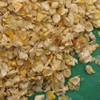
|
Maize germ

|
Good quality ingredient with beneficial nutrients
|
|
Like wheat germ and rice germ, maize germ is the part of the grain that would grow into the new plant. Relative to the whole maize grain, the germ is tiny making up only about 10% of the total weight, but it contains the vast majority of the grain's non-carb nutrients including a very high level of essential omega-6 oils and other healthy unsaturated oils along with a good dose of vitamin E, A and K.
Many canine nutritionists believe that the carbs in maize are more difficult to digest than those in many other grains making it more likely to lead to dietary intolerance. Maize germ, on the other hand, does not include any of the starchy endosperm (the source of virtually all of the grain's carbohydrates and gluten) which makes it much less likely to lead to any adverse reaction.
Find foods containing Maize germ
Go back to top
|
|
|
Maize gluten

|
Inferior or controversial ingredient
|
|
Maize gluten (sometimes called maize gluten meal, corn gluten or prairie meal) is a by-product of maize processing and can be used to top-up the protein levels of dog foods, usually as an alternative to more expensive meat-proteins. Unfortunately, maize gluten protein is not as easy for dogs to deal with as protein from meat sources and as a result it can lead to health issues like skin problems and hyperactivity. For this reason, we would recommend steering clear of maize gluten, especially with sensitive dogs.
Find foods containing Maize gluten
Go back to top
|
|
|
Millet

|
Good quality ingredient with beneficial nutrients
|
|
Millet is a grain that is relatively easy for dogs to digest and is rich in B vitamins, iron and potassium. Millet is also gluten free and so makes a useful carbohydrate choice for hypoallergenic diets.
Find foods containing Millet
Go back to top
|
|
|
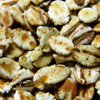
|
Oats

|
Medium quality ingredient - nutritionally adequate and unlikely to cause any problems e.g. fillers etc
|
|
Oats are used very widely in dog foods. They are a good source of dietary fibre as well as a host of micronutrients including manganese, selenium, vitamin B1, magnesium and phosphorus. Once cooked, oats are relatively easily digested by dogs.
Find foods containing Oats
Go back to top
|
|
|
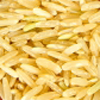
|
Rice - brown / whole grain

|
Good quality ingredient with beneficial nutrients
|
|
Rice comes in many forms, from long grain and basmati varieties to shorter forms like pearl rice and short-grain rice. The nutritional characteristics of most forms of rice is very similar, and most varieties can be found in both their whole, brown form and their polished, white form.
Brown rice (or whole-grain rice as it is also known) is widely regarded as a 'superfood' for humans and as long as it is well cooked, it is easily digested by dogs. It contains a whole host of natural nutrients including three B vitamins, iron, manganese, selenium, magnesium and omega-3 oils. It is also a good source of dietary fibre which is important in maintaining intestinal health. It is the grain of choice for most British natural dog food producers.
Find foods containing Rice - brown / whole grain
Go back to top
|
|
|
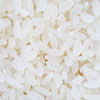
|
Rice - white

|
Medium quality ingredient - nutritionally adequate and unlikely to cause any problems e.g. fillers etc
|
|
Rice comes in many forms, from long grain and basmati varieties to shorter forms like pearl rice and short-grain rice. The nutritional characteristics of most forms of rice is very similar, and most varieties can be found in both their whole, brown form and their polished, white form.
White rice is simply brown rice that has been milled and polished to remove outer bran, germ and aleurone layers. Unfortunately, these layers contain the vast majority of the grain's nutrients and once removed the remaining white rice is almost entirely starch.
On ingredient lists, white rice is often listed simply as 'rice'. In general, unless it specifically says that the rice is brown or whole grain, it is usually safe to assume the rice being used is white.
Find foods containing Rice - white
Go back to top
|
|
|
Rice bran

|
Good quality ingredient with beneficial nutrients
|
|
During the production of white rice, the outer layers of the grain are removed as a by-product known as rice bran. Without the starchy white part of the rice, rice bran is incredibly nutritious, with abundant vitamins B1, B3 and B6, iron, manganese, selenium, magnesium and omega-3 oils as well as health-promoting natural antioxidants. Rice Bran is an excellent source of high-quality fibre which is important for over-all digestive health.
Find foods containing Rice bran
Go back to top
|
|
|
Rice germ

|
Good quality ingredient with beneficial nutrients
|
|
Before processing, rice grains are made up of four parts: the hard outer hull, the inner seed coat or pericarp, the starchy endosperm (which goes on to make white rice) and the embryo or germ. The germ is a fairly insubstantial part of the whole grain, comprising only about 2% of the whole, but it is this tiny bud that would grow into a new rice plant, using the endosperm as its food source.
Despite it's small size, the germ contains a very large proportion of the rice grain's vitamins and is very rich in several B vitamins, particularly thiamine.
Rice bran is made up of the pericarp and the germ.
Find foods containing Rice germ
Go back to top
|
|
|
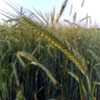
|
Rye

|
Good quality ingredient with beneficial nutrients
|
|
Rye is a high quality grain with a nutritional profile fairly similar to that of barley. It is one of the three 'gluten-grains' (the others being wheat and barley) making it unsuitable for celiac dogs or many dogs with grain intolerance. As with all grains, rye is best in its whole grain form as it retains much more of its nutrients.
Find foods containing Rye
Go back to top
|
|
|
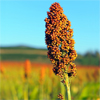
|
Sorghum

|
Medium quality ingredient - nutritionally adequate and unlikely to cause any problems e.g. fillers etc
|
|
Sorghum is a grass and its grain is widely used in dog foods as an inexpensive alternative to traditional grains. Sorghum grain is high in starch and has a similar nutrient profile to maize. Like maize, it does not compare well against higher-quality grains like rice, oats and barley. Unlike maize though, sorghum is gluten free so it is often recommended for dogs that are prone to food intolerance.
Find foods containing Sorghum
Go back to top
|
|
|
Spelt

|
Medium quality ingredient - nutritionally adequate and unlikely to cause any problems e.g. fillers etc
|
|
Spelt is an ancient variety of wheat which has been cultivated by people since the bronze age. It provides a much broader range of nutrients than common wheat and is a good source of B vitamins, magnesium and fibre. Probably because it has been with us and our dogs for so long, many dogs and people that are intolerant to wheat seem to have no problems with spelt. Spelt does however contain wheat gluten and so should not be fed to coeliac dogs.
Find foods containing Spelt
Go back to top
|
|
|
Spelt protein

|
Medium quality ingredient - nutritionally adequate and unlikely to cause any problems e.g. fillers etc
|
|
Spelt is an ancient variety of wheat which has been cultivated by people since the bronze age. It is about 17% protein and contains a broad range of amino acids. For this reason, isolated spelt protein is sometimes used to top up a food's protein content. Probably because it has been with us and our dogs for so long, many dogs and people that are intolerant to wheat protein seem to have no problems with spelt protein. Spelt protein does however include gluten and so should not be fed to coeliac dogs. As always, we recommend sticking with foods with a good source of meat proteins as, from our experience, vegetable and grain proteins can be harder for dogs to digest.
Find foods containing Spelt protein
Go back to top
|
|
|

|
Wheat

|
Particularly low grade, highly contentious or excessively vague ingredient we usually recommend avoiding
|
|
Wheat is a common staple in many lower-grade dry dog foods as it is inexpensive and is ideal for forming biscuits and kibbles. It is, however, regularly linked with dietary intolerance in dogs which makes it a highly controversial ingredient.
In wheat intolerant dogs (also called celiacs), the gluten protein contained in the grain damages the lining of the small intestine and prevents it from absorbing parts of food that are important for staying healthy. Wheat intolerance can therefore lead to wide-ranging health problems most commonly affecting the skin, coat and digestive system.
Find foods containing Wheat
Go back to top
|
|
|
Wheat feed

|
Particularly low grade, highly contentious or excessively vague ingredient we usually recommend avoiding
|
|
Although finding a strict definition is quite difficult, wheat feed appears to be the general term used for wheat that does not meet meet the standards necessary for human consumption. It is therefore only suitable for animal feed - usually for farm animals like horses, cows and pigs.
Since wheat is widely regarded as a problematic ingredient for dogs and since this is the dregs of the wheat industry, wheat feed is certainly well worth avoiding.
Find foods containing Wheat feed
Go back to top
|
|
|
Wheat germ

|
Good quality ingredient with beneficial nutrients
|
|
Like maize germ and rice germ, wheat germ is the part of the grain that would grow into the new plant. Relative to the whole wheat grain, the germ is tiny making up only about 3% of the total weight, but it contains the vast majority of the grain's non-carb nutrients including a very high level of essential fatty acids and other healthy unsaturated oils along with a good dose of B vitamins, vitamin E, phosphorous, zinc and magnesium.
The carbohydrates found in wheat are more difficult for dogs to digest than those in many other grains making it more likely to lead to dietary intolerance. Wheat germ, on the other hand, does not include any of the starchy endosperm (the source of virtually all of the grain's carbohydrates and gluten) which makes it much less likely to lead to any adverse reaction.
Find foods containing Wheat germ
Go back to top
|
|
|
Vegetablesand vegetable products
|
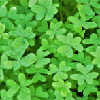
|
Alfalfa / Lucerne

|
Good quality ingredient with beneficial nutrients
|
|
Alfalfa (or lucerne as it is often called in the UK) is part of the legume family of plants making it a cousin of clover, peas and beans and, depending on how much there is in a food, it can be good or bad.
In it's whole form, alfalfa is widely regarded as a superfood for humans and, in small amounts, can be very beneficial for our dogs. It is a good, natural source of a whole host of nutrients including plenty of vitamins and minerals - most notably iron, magnesium, manganese, vitamin A, C, E and several B vitamins, as well as good quality fibre.
Since alfalfa also contains a fairly high proportion of protein, it can also be used in larger amounts as a protein supplement. Since dogs generally do a lot better on meat proteins than vegetable-derived forms, this is not something we recommend.
As a rule of thumb, if you see alfalfa listed in the top half of the ingredients list, chances are it is there as a cheap source of protein and is probably best avoided. In the bottom half, it is much more likely that it is just a small amount to provide valuable micronutrients and is no cause for concern.
Find foods containing Alfalfa / Lucerne
Go back to top
|
|
|
Barley grass

|
Good quality ingredient with beneficial nutrients
|
|
Barley grass is made from the leaves of barley plants and is becoming popular as a health supplement for both humans and dogs. It contains a high density of a wide range of nutrients and is sometimes suggested as a natural anti-oxidant and anti-inflammitory. Like oat grass and wheatgrass, barley grass does not contain the sometimes problematic proteins found in barley grains and so it can be given to cereal sensitive dogs.
Find foods containing Barley grass
Go back to top
|
|
|

|
Carrots

|
Good quality ingredient with beneficial nutrients
|
|
Carrots are excellent sources of vitamin A (which is used in the eye to maintain healthy vision), as well as numerous minerals, soluble fibre and abundant natural anti-oxidants. Once cooked, carrots are relatively easily digested by dogs.
Find foods containing Carrots
Go back to top
|
|
|
Chicory

|
Good quality ingredient with beneficial nutrients
|
|
Chicory is a plant with bright blue flowers that grows wild across Europe and North America. Various forms are cultivated for their leaves or their buds but the form most often used in dog food is grown for its large tuberous roots.
Chicory root is rich in simple sugars and the polysaccharide inulin. Studies suggest that inulin can have a beneficial effect on the gut's 'good bacteria' which is making it increasingly popular as a prebiotic and as a source of soluble dietary fibre. Inulin is also fairly sweet making it a popular natural dog food flavour enhancer.
Inulin is often extracted from the chicory root and may therefore be listed as chicory extract, chicory root extract or occasionally as chicory syrup.
It has also been suggested that some of the oils naturally found in chicory can help to eliminate a dog's intestinal worms.
Find foods containing Chicory
Go back to top
|
|
|

|
Derivatives of vegetable origin

|
Particularly low grade, highly contentious or excessively vague ingredient we usually recommend avoiding
|
|
Defined as "derivatives resulting from the treatment of vegetable products, in particular cereals, vegetables, legumes and oil seed", 'derivatives of vegetable origin' can refer to an extremely wide range of ingredients, from some of the best to some of the worst.
Although 'derivatives of vegetable origin' does not necessarily refer to a bad ingredient, it could and there's no way of knowing. It's vagueness also allows the manufacturer to change formula from one batch to another depending on what vegetable products are available at the time.
Because it is impossible to know what 'derivatives of vegetable origin' refers to, it is usually best to assume the worst and treat it with caution. This is particularly important if your dog is prone to dietary intolerance as identifying and eliminating problem ingredients is impossible unless you know exactly what you are feeding.
Find foods containing Derivatives of vegetable origin
Go back to top
|
|
|

|
Garlic

|
Good quality ingredient with beneficial nutrients
|
|
As many dog owners know, very large doses of garlic can be dangerous for dogs - a fact that has led to garlic being omitted from most dogs' diets for decades, but what most dog owners don't know is that small amounts of garlic can actually be extremely beneficial.
Basically, garlic helps to keep your dog free from all sorts of nasties: it is an effective anti-fungal and anti-bacterial, it helps to eliminate intestinal worms and it acts as a deterrant to skin parasites like ticks. For these reasons, garlic can be a real help for dogs with all sorts of ailments and infections caused by bacterial, fungal or parasitic infection. And it's benefits don't stop there. Garlic has been linked with lowering blood sugar in diabetics, to aiding joint mobility and even to lowering blood cholesterol!
Some dog foods are now starting to include garlic in their recipes but if you would like to add your own, roughly one clove per 10kg of body weight per day is a good place to start. Toxic doses really have to be quite huge (as much as two whole bulbs per day for an extended period) so don't be too concerned about over feeding garlic.
Find foods containing Garlic
Go back to top
|
|
|
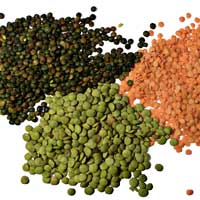
|
Lentils

|
Good quality ingredient with beneficial nutrients
|
|
Over the last decade or so, lentils and other legumes have become increasingly popular in pet foods as alternatives to grains.
Lentils have been cultivated by humans for over 11,000 years giving rise to dozens of different forms all over the world. It's therefore reasonable to assume that they have been at least some part of the diet of domesticated dogs for around the same length of time.
In moderation, lentils are a great source of nutrients for dogs. As well as abundant fibre and protein, they provide a rich source of numerous nutrients including B vitamins, phosphorus, iron, zinc and carotenoids amongst others.
Their low starch content and high fibre make lentils a useful option for diabetic dogs and since they tend to leave a dog feeling fuller for longer, they can also help take the edge off for very hungry dogs.
Lentils are, however, not without their controversies. First off, too much lentil in any food and it starts looking less like a healthy addition chosen for its nutritional value and more like a filler chosen for its relatively low cost.
Then there's the question of lectins - a group of potentially problematic proteins found in lentils and other legumes. Take a look at our article here for more information on lectins and how to mitigate any risks they may pose to your dog.
And lastly is the recent highly questionable association of legumes including lentils with the DCM heart condition in pets. Although this has caused a certain amount of hysteria in some parts of the pet community, at this stage (Feb 2020) there really is no evidence to support these claims. You can find lots more information on the matter here.
While these factors may put many off of feeding diets containing lentils to their dogs, at this stage and with the knowledge currently available I think the benefits of lentils still outweigh any potential risks.
Find foods containing Lentils
Go back to top
|
|
|
Maca

|
Good quality ingredient with beneficial nutrients
|
|
Lepidium meyenii, known as maca or Peruvian ginseng, is an edible herbaceous biennial plant of the family Brassicaceae that is native to South America in the high Andes mountains of Peru and Bolivia.
Maca has been seen to have various health benefits, such as boosting libido, increasing fertility, boosting energy and improving mood.
Find foods containing Maca
Go back to top
|
|
|
Oat grass

|
Good quality ingredient with beneficial nutrients
|
|
Oat grass is less well known than barley grass or wheatgrass but nevertheless still offers many of the same beneficial nutrients. Oat grass is rich in a wide range of both vitamins and minerals. Like barley grass and wheatgrass, oat grass does not contain the sometimes problematic proteins found in oat grains making it suitable for cereal sensitive dogs.
Find foods containing Oat grass
Go back to top
|
|
|
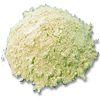
|
Pea flour

|
Medium quality ingredient - nutritionally adequate and unlikely to cause any problems e.g. fillers etc
|
|
Pea flour is a powder milled from roasted peas. In small amounts, pea flour can be a good dog food ingredient as it is rich in iron and calcium and is also high in fibre.
Pea flour also contains a high proportion of protein and is sometimes used in higher proportions as a protein supplement. Unfortunately, dogs cannot digest plant proteins as well as those found in meats so, as far as we're concerned, they should never take the place of good quality meat ingredients.
Find foods containing Pea flour
Go back to top
|
|
|
Pea protein

|
Medium quality ingredient - nutritionally adequate and unlikely to cause any problems e.g. fillers etc
|
|
Pea protein is a byproduct of pea processing and is used as a protein source in some dog foods. Although it is far less expensive, we don't think pea protein should be used as an alternative to meat in dog foods since the quality and digestibility of vegetable proteins tend to fall a long way short of those found in meats.
Find foods containing Pea protein
Go back to top
|
|
|
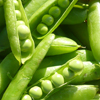
|
Peas

|
Good quality ingredient with beneficial nutrients
|
|
Peas have been a common dog food ingredient for years but the recent rise of grain free foods has seen their popularity skyrocket.
In moderation, whole peas (as opposed to refined pea protein or pea flour) are a great source of health-promoting antioxidants as well as a wide spectrum of nutrients including vitamins C, K and B1, manganese, fibre and folate, all of which are highly beneficial to dogs. They also contain a relatively high level of protein which, while not nearly as desirable as animal protein, may help to shore up any amino acids that may otherwise be lacking in the diet.
Peas are, however, not without their controversies. First off, too much pea in any food and it starts looking less like a healthy addition chosen for its nutritional value and more like a filler chosen for its relatively low cost.
Then there's the question of lectins - a group of potentially problematic proteins found in peas and other legumes. Take a look at our article here for more information on lectins and how to mitigate any risks they may pose to your dog.
And lastly is the recent highly questionable association of legumes including peas with the DCM heart condition in pets. Although this has caused a certain amount of hysteria in some parts of the pet community, at this stage (Feb 2020) there really is no evidence to support these claims. You can find lots more information on the matter here.
While these factors may put many off of feeding diets containing peas to their dogs, at this stage and with the knowledge currently available I think the benefits of peas still outweigh any potential risks.
Find foods containing Peas
Go back to top
|
|
|
Potato protein

|
Medium quality ingredient - nutritionally adequate and unlikely to cause any problems e.g. fillers etc
|
|
Potato protein is a byproduct of potato processing and is used as a protein source in some dog foods. Although it is far less expensive, we don't think potato protein should be used as an alternative to meat in dog foods since the quality and digestibility of vegetable proteins tend to fall a long way short of those found in meats.
Find foods containing Potato protein
Go back to top
|
|
|
Potato starch

|
Medium quality ingredient - nutritionally adequate and unlikely to cause any problems e.g. fillers etc
|
|
Potatoes are becoming more popular in dog foods as anti-grain sentiment continues to increase. Potato starch often forms the all important binding agent in grain-free dry foods, without which the biscuits simply wouldn't form.
Unfortunately, while whole potatoes contain a range of healthy nutrients, pure potato starch contains... well, pure starch and many nutritionists still have doubts over whether dogs can digest significant amounts of starches efficiently.
Find foods containing Potato starch
Go back to top
|
|
|
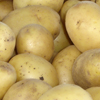
|
Potatoes

|
Medium quality ingredient - nutritionally adequate and unlikely to cause any problems e.g. fillers etc
|
|
Potatoes are becoming more popular in dog foods as anti-grain sentiment continues to increase. Potatoes are predominantly made up of starch, although some varieties like russet potatoes are especially starchy. There is some debate over the ability of dogs to digest starch efficiently but where it is digested it is broken down into its constituent simple sugars. For this reason, starchy foods like potatoes may not be the best choice for diabetic dogs. Potatoes do however also contain some dietary fibre as well as vitamin C, vitamin B6 and potassium.
Find foods containing Potatoes
Go back to top
|
|
|
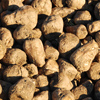
|
Sugar Beet

|
Medium quality ingredient - nutritionally adequate and unlikely to cause any problems e.g. fillers etc
|
|
Beet pulp (the fibrous material from sugar beets which is left-over after sugar production) is used in dog food as a dietary fibre supplement. The sugar is almost completely removed leaving behind an excellent source of both soluble and insoluble fibre. Fibre helps to promote general digestive health in dogs. Nevertheless, beet pulp continues to be a topic of debate with many critics arguing that it is little more than a filler and an un-natural food for dogs. With little solid evidence either way, the jury is still out on beet pulp.
Find foods containing Sugar Beet
Go back to top
|
|
|
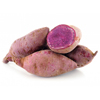
|
Sweet Potatoes

|
Good quality ingredient with beneficial nutrients
|
|
Not a true potato at all, the sweet potato is nutritionally quite different from common potatoes. It contains much more fibre, it is an fantastic source of vitamin A, and is also rich in vitamins C and B6 and several minerals.
It is also much higher in sugar than common potatoes but despite this, recent studies have shown that sweet potatoes might actually be beneficial for diabetics since they can help to stabilize blood sugar levels and lower insulin resistance.
For both humans and dogs, sweet potatoes are generally regarded as a very high quality carbohydrate source.
Find foods containing Sweet Potatoes
Go back to top
|
|
|
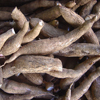
|
Tapioca

|
Medium quality ingredient - nutritionally adequate and unlikely to cause any problems e.g. fillers etc
|
|
Tapioca (sometimes called cassava) is a starch extracted from the root of the cassava plant. It is often used as a carbohydrate source in grain free dog foods but due to its general lack of all nutrients other than starch, it is generally regarded as a low grade filler for dogs.
Find foods containing Tapioca
Go back to top
|
|
|

|
Tomatoes

|
Good quality ingredient with beneficial nutrients
|
|
Tomatoes are an excellent natural source of health-promoting vitamins A, C and K as well as high quality dietary fibre. They also contain plenty of minerals and other micro-nutrients including molybdenum, potassium, chromium and manganese.
Find foods containing Tomatoes
Go back to top
|
|
|
Vegetable fibre

|
Medium quality ingredient - nutritionally adequate and unlikely to cause any problems e.g. fillers etc
|
|
'Vegetable fibre' can refer to any fibre from a vegetable but is commonly used as a more consumer friendly term for sugar beet pulp. Fibre is a necessary part of a dog's diet and helps to promote general digestive health.
Find foods containing Vegetable fibre
Go back to top
|
|
|
Vegetable oil

|
Medium quality ingredient - nutritionally adequate and unlikely to cause any problems e.g. fillers etc
|
|
Vegetable oil is a general term used for any oil of plant origin. In general it is used to refer to lower-quality oils like rapeseed, palm or corn oil. It is added to some dog foods as an alternative to more expensive (and more nutritious) fats and oils like animal fat, olive oil or sunflower oil. As always, it is best to look for a food where each ingredient is accurately identified.
Find foods containing Vegetable oil
Go back to top
|
|
|

|
Vegetable protein extracts

|
Particularly low grade, highly contentious or excessively vague ingredient we usually recommend avoiding
|
|
Vegetable protein extract (or isolate) is another term that doesn't shed any real light on what is in the food. It gives no indication of which vegetables are used, nor does it say how the protein is extracted, although the most common methods involve chemical reactions that are far from what most people would regard as 'natural'.
For dogs, vegetable proteins are nutritionally inferior to those found in meat. Common sources of vegetable protein include soya, maize and wheat which have all been linked to dietary intolerance and, in our opinion, should be avoided with sensitive dogs.
Some nutritionists have also speculated that vegetable protein extracts might also be a pseudonym for MSG (monosodium glutamate), the controversial food additive that some believe to be mildly addictive.
Find foods containing Vegetable protein extracts
Go back to top
|
|
|

|
Vegetables

|
Medium quality ingredient - nutritionally adequate and unlikely to cause any problems e.g. fillers etc
|
|
This general term can be used for all vegetables and legumes. Although most vegetables are excellent additions to dog foods, this term may also be used for less appealing ingredients like sugar beet, potatoes or even soya beans! Broad terms like this also allow the recipe to be altered from batch to batch so it is always best to look for foods that identify each ingredient being used.
Find foods containing Vegetables
Go back to top
|
|
|
Wheatgrass

|
Good quality ingredient with beneficial nutrients
|
|
Wheatgrass is packed with beneficial nutrients from vitamins and minerals to amino acids and enzymes. It is a common nutritional supplement for people and has been linked with various curative properties. Although wheatgrass is made from the leaves and stems of the wheat plant, it contains no wheat gluten and so is suitable for wheat sensitive dogs.
Find foods containing Wheatgrass
Go back to top
|
|
|

|
Yucca Extract

|
Good quality ingredient with beneficial nutrients
|
|
Yucca is a plant that grows mostly in desert areas of the United States and Mexico. Extract from the yucca plant is said to naturally help the body remove toxins and facilitate digestion. Yucca extract may also reduce body odour as well as the smell of the urine/feaces.
Find foods containing Yucca Extract
Go back to top
|
|
|
Fruits, beans & seedsand their products
|
Borage oil

|
Good quality ingredient with beneficial nutrients
|
|
Like evening primrose oil, borage oil is an excellent source of gamma-linolenic acid (GLA) which has an anti-inflammatory effect and is often recommended in the natural treatment of arthritis as well as certain skin conditions.
Find foods containing Borage oil
Go back to top
|
|
|
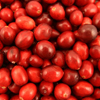
|
Cranberries

|
Good quality ingredient with beneficial nutrients
|
|
Cranberries are rich in vitamin C and health-promoting antioxidants. They have also been widely recognised as helping to prevent urinary tract infections (UTI's) by preventing the harmful bacteria and fungi from latching on to the wall of the urinary tract.
Find foods containing Cranberries
Go back to top
|
|
|

|
Evening Primrose Oil

|
Good quality ingredient with beneficial nutrients
|
|
Evening primrose is a plant that is native to North America but now grows wild all over the world. Its name comes from the fact that its yellow flowers tend to bloom in the evening.
Oil from the seeds of the evening primrose is used as a supplement for humans and pets due to its high concentration of the essential oil gamma-linolenic acid (GLA). Essential oils like GLA are needed by the body to remain healthy but since they cannot be made by the body, they have to be obtained from the diet.
Evening primrose oil is most commonly recommended as a natural anti-inflammatory for dogs with skin problems and joint issues and is also sometimes suggested for digestive upsets like colitis and irritable bowel syndrome (IBS).
Find foods containing Evening Primrose Oil
Go back to top
|
|
|
Grape Seed Extract

|
Good quality ingredient with beneficial nutrients
|
|
Grape seed extract is a strong antioxidant that helps to support the immune system. It can also have an anti-inflammatory effect and so is often recommended for dogs with allergic skin conditions.
Unlike whole grapes, grape seed extract is not toxic to dogs.
Find foods containing Grape Seed Extract
Go back to top
|
|
|
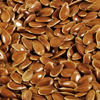
|
Linseed

|
Good quality ingredient with beneficial nutrients
|
|
Linseed is also known as flax or flaxseed. The seeds contain high levels of good quality dietary fiber, lignans (natural antioxidants) and an abundance of other micronutrients.
Linseed's main benefit though is its high proportion of health-boosting omega-3 fatty acids. Although these aren't quite of the same standard as the omega-3's found in fish oils, they are still fantastic for your dog's health. The oils can be extracted from the seeds and added to foods as linseed (or flaxseed) oil.
Find foods containing Linseed
Go back to top
|
|
|
Lupini beans

|
Medium quality ingredient - nutritionally adequate and unlikely to cause any problems e.g. fillers etc
|
|
Lupini beans, or lupin, are a less allergenic alternative to soya beans. They are added to some dog foods as an inexpensive protein source but, like all vegetable derived proteins, lupin is a poor substitute for good quality meat.
Find foods containing Lupini beans
Go back to top
|
|
|
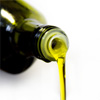
|
Olive oil

|
Good quality ingredient with beneficial nutrients
|
|
Olive oil is a high quality food supplement with proven benefits to the coat and to the heart. It contains numerous antioxidants and is a good source of vitamin E.
Find foods containing Olive oil
Go back to top
|
|
|
Psyllium

|
Medium quality ingredient - nutritionally adequate and unlikely to cause any problems e.g. fillers etc
|
|
The husks of psyllium seeds are sometimes added to dog foods as a source of soluble fibre which is important for maintaining digestive health.
Find foods containing Psyllium
Go back to top
|
|
|
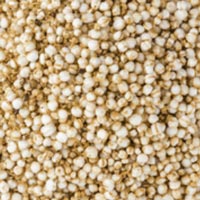
|
Quinoa

|
Good quality ingredient with beneficial nutrients
|
|
Quinoa is a pseudo-grain. Unlike true grains, it is not part of the grass family but is made from the seeds of a spinach like plant.
As you might expect, quinoa is first and foremost a carbohydrate providing almost the same percentage of carbs as white rice. Nevertheless, it is also packed with protein, fibre and micronutrients making it a surprisingly beneficial ingredient for dogs.
Although plant proteins are generally no substitute for those from meat sources (for dogs at least), quinoa does arguably come close. It contains a high proportion of protein and includes all 10 canine essential amino acids making it one of the few non-meat complete proteins.
Quinoa also contains a high proportion of fibre which plays an important part in digestive health.
To round off quinoa's impressive nutrient profile, it also provides Omega-3 fatty acids as well as a wide array of micronutrients including manganese, copper, phosphorus, magnesium and several B-complex vitamins.
Quinoa is becoming increasingly popular in sensitive diets since most dogs have never eaten it which means they haven't had opportunity to develop any kind of reaction. The rule is, you can't be allergic to something you have never been exposed to.
As with most seeds and grains, quinoa must be cooked before it can be properly digested by dogs so you won't find it in any raw pet foods.
Find foods containing Quinoa
Go back to top
|
|
|
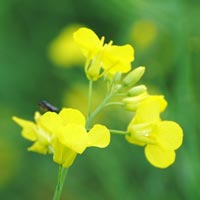
|
Rapeseed oil

|
Good quality ingredient with beneficial nutrients
|
|
For a long time rapeseed oil was only used for industrial purposes as its relatively high levels of the toxin erucic acid made it suitable for human or animal consumption. But then, in the 1970's, varieties were developed with low erucic acid levels and human-grade rapeseed oil (often branded as 'canola') began to make its way into both human and animal food industries.
Nowadays, human-grade rapeseed oil is everywhere. It is most often sold as 'vegetable oil' in supermarkets and is also used widely in pet foods. On the label, it can be listed as rapeseed oil, canola, vegetable oil or simply under the umbrella term 'oils and fats'.
Although rapeseed oil can still contain some erucic acid (currently up to 5% in the UK and Europe), the levels are reportedly far too low to cause any health problems.
Compared with other vegetable oils, rapeseed oil measures up well. It is low in saturated fats and has a high content of linolenic acid (omega-3 oils). It also tolerates high temperatures well which is especially important for oils used in extruded biscuits (which account for most dry pet foods).
Find foods containing Rapeseed oil
Go back to top
|
|
|
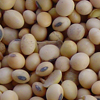
|
Soya

|
Inferior or controversial ingredient
|
|
Soya beans (soya, soybean protein, soya meal) are high in protein and are often added to foods as a low-cost meat substitute. Unfortunately, the proteins in soya are much less bio-available to dogs than normal meat proteins meaning that far less can be digested and used. Soya has also been consistently linked by veterinarians to food intolerance and allergies and is therefore best avoided if your dog is very sensitive.
Find foods containing Soya
Go back to top
|
|
|
Soybean oil

|
Medium quality ingredient - nutritionally adequate and unlikely to cause any problems e.g. fillers etc
|
|
Soybean oil, like all vegetable oils, is cholesterol free but as it contains more saturated fat than most other vegetable oils it is generally regarded as a lower-grade option. Soya oil is free from soya proteins and therefore does not upset dogs with soya intolerance.
Find foods containing Soybean oil
Go back to top
|
|
|

|
Sunflower oil

|
Good quality ingredient with beneficial nutrients
|
|
Sunflower oil is pressed from sunflower seeds and is generally regarded as one of the healthier oils in dog foods. It is low in saturated fat and is rich in the natural anti-oxidant vitamin E.
Find foods containing Sunflower oil
Go back to top
|
|
|
Herbs
|
Devil's Claw

|
Medium quality ingredient - nutritionally adequate and unlikely to cause any problems e.g. fillers etc
|
|
Harpagophytum, or devil's claw as it is more commonly known, is a plant that grows in the deserts of southern Africa. It has been used in the treatment of arthritis for centuries and clinical trials have shown that it is as effective as many arthritis medicines in reducing joint pain and easing mobility. It is, however, rarely used in dog foods due to its relatively high cost.
Find foods containing Devil's Claw
Go back to top
|
|
|

|
Green Tea

|
Good quality ingredient with beneficial nutrients
|
|
Green tea and its extract contains powerful health-promoting antioxidants called catechins which have wide-ranging benefits but are particularly good for the cardiovascular system.
Find foods containing Green Tea
Go back to top
|
|
|

|
Herbs

|
Medium quality ingredient - nutritionally adequate and unlikely to cause any problems e.g. fillers etc
|
|
The general terms 'herbs', 'culinary herbs', 'herbal mix' and so on can refer to any plants with leaves, seeds, or flowers used for their flavour, aroma, nutritional constituents or medicinal properties. This obviously includes a great number of ingredients with very different attributes and qualities. General terms like these are often used by dog food manufacturers to disguise the true contents of the food. This may be because the mixture changes from batch to batch or because an accurate list would put customers off or occasionally to prevent competitors from getting hold of the recipe.
Find foods containing Herbs
Go back to top
|
|
|
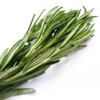
|
Rosemary

|
Good quality ingredient with beneficial nutrients
|
|
Rosemary is sometimes used in dog foods in its whole form which has a number of uses in herbal medicine, but more often its oil is used as a natural preservative. Rosemary oil (or as it is also known, rosemary extract) is a powerful antioxidant which is able to slow down the oxidisation process that turns fats rancid. As an antioxidant, rosemary oil may also help to reduce the risk of cancer.
Rosemary is widely regarded by herbalists as a natural stimulant. Although this is fine for most dogs, it is often suggested that it should not be given to epileptic dogs as it may increase the incidence or severity of seizures. Some nutritionists have also proposed that, because rosemary can effect uterine function and menstrual flow, it may be dangerous during pregnancy. Although there is some anecdotal evidence to support these claims, there haven't yet been any scientific studies on either issue in dogs so I'm afraid the jury remains out for now. In the meantime, I generally recommend avoiding rosemary if your dog is pregnant or prone to seizures, just to be extra safe, although it must be said that I haven't personally encountered any dogs that have definitely reacted badly to the herb.
Find foods containing Rosemary
Go back to top
|
|
|
Supplements
|
Calcium Carbonate

|
Medium quality ingredient - nutritionally adequate and unlikely to cause any problems e.g. fillers etc
|
|
Calcium carbonate is widely used in dog foods as a calcium supplement and less frequently as an acidity regulator, colouring, anti-caking agent or stabiliser. It can be derived from a number of sources including bone meal, oyster shells, limestone, and dolomite (clay). Calcium carbonate can also help to ease symptoms of irritable bowel syndrome (IBS) but excessive calcium can have serious side effects so adding extra to a complete food is generally not recommended.
Find foods containing Calcium Carbonate
Go back to top
|
|
|
Calcium phosphate

|
Medium quality ingredient - nutritionally adequate and unlikely to cause any problems e.g. fillers etc
|
|
Calcium phosphate refers to a family of minerals that are usually derived from cow milk and are added to dog foods as a source of calcium and phosphorous. Calcium phosphate is the primary constituent of bone and tooth enamel.
Find foods containing Calcium phosphate
Go back to top
|
|
|
Chondroitin

|
Good quality ingredient with beneficial nutrients
|
|
Chondroitin sulphate is a naturally occurring molecule which is well known for easing the symptoms of osteoarthritis and other joint conditions. It acts as a natural anti-inflammatory and also blocks the enzymes that attack the joints during osteoarthritis.
Chondroitin is a component of animal cartilage and meat and is therefore present in small amounts in virtually all dog foods. Many dog foods, especially those designed for older dogs or large breed dogs, have added chondroitin to provide additional joint support. Supplemented chondroitin sulphate is manufactured from animal sources, such as cow cartilage.
Find foods containing Chondroitin
Go back to top
|
|
|
Copper sulphate

|
Inferior or controversial ingredient
|
|
Dogs need copper but they cannot make it themselves so it must be taken in through the diet. Although all dog foods naturally contain a certain amount of copper from the raw ingredients, additional copper is routinely added to ensure there is enough for the dog's requirements.
While there are several forms of copper supplement available to pet food manufacturers, copper sulphate has been their number one source for near on 80 years. It is approved by both AAFCO in the US and FEDIAF in Europe and its use in pet food has never been directly associated with any pet illnesses. Despite this fact, though, copper sulphate remains a somewhat controversial ingredient with some parties claiming that copper sulphate is 'moderately poisonous' or even 'toxic' to pets.
Much of the criticism stems from the fact that pure copper sulphate is not a particularly pleasant substance. In the EU, for example, it is classified as 'harmful' and 'dangerous to the environment' as well as being an 'irritant'. Naturally, these are not the kind of terms you want to see linked with pet food ingredients but it is important to note that the amounts found in pet foods are absolutely tiny - far below the amounts that would be needed to cause harm.
Nevertheless, some manufacturers prefer to err on the side of caution and opt for less contentious forms of copper supplements like copper gluconate, copper carbonate or chelated copper (often listed as copper amino acid complex or copper proteinate and widely regarded as the safest and most absorbable form of copper supplement).
As a standard mineral supplement, copper sulphate is not required to be mentioned on the label so if you would prefer to avoid it, the only way to be sure is to contact your pet food manufacturer directly.
Find foods containing Copper sulphate
Go back to top
|
|
|
D,L-methionine

|
Medium quality ingredient - nutritionally adequate and unlikely to cause any problems e.g. fillers etc
|
|
Methionine is an amino acid - a building block of protein. It is naturally found in a wide range of foods but extra is sometimes added to dog foods as it reduces the pH of the urine which helps prevent damage to lawns.
Find foods containing D,L-methionine
Go back to top
|
|
|
FOS

|
Good quality ingredient with beneficial nutrients
|
|
Fructo-oligo-saccharide (FOS) is a nutritional supplement which is becoming more popular in dog foods due to its beneficial pre-biotic effect. It encourages the growth of 'friendly bacteria' in the large intestine which promotes over-all gastro-intestinal (GI) health. FOS is extracted from fruits and vegetables such as chicory and some grains like barley and wheat.
Find foods containing FOS
Go back to top
|
|
|
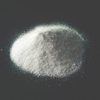
|
Glucosamine

|
Good quality ingredient with beneficial nutrients
|
|
Glucosamine sulphate (often just called glucosamine) is widely recommended for sufferers of joint problems (especially osteoarthritis) and is one of the most common non-vitamin, non-mineral, dietary supplements for both humans and dogs.
Although it's not clear exactly how glucosamine works, or even if it works, most scientists believe that it helps to prevent the break down of the joint cartilage. Unfortunately, in clinical trials, results have been mixed and glucosamine's effectiveness is still in question.
Glucosamine can be found naturally in animal bones and bone marrow and so is present in small amounts in all meat-based dog foods. Nevertheless, many dog foods, especially those designed for older dogs or large breed dogs, have added glucosamine to provide additional joint support. Commercially manufactured glucosamine usually comes from the hydrolysis of the shells of crustaceans (shrimps, crabs etc) where it is particularly abundant.
Find foods containing Glucosamine
Go back to top
|
|
|
L-Carnitine

|
Medium quality ingredient - nutritionally adequate and unlikely to cause any problems e.g. fillers etc
|
|
Carnitine (L-Carnitine) is an amino acid (one of the building blocks of proteins) which as a supplement is widely recommended for dogs with heart disorders and dogs on weight loss programs. It is naturally produced by animal cells and is therefore found in small amounts in virtually all dog foods. L-carnitine has a central role in the metabolism of fats and so extra carnitine is often added to weight-loss diets as it helps to break down body fat while maintaining lean muscle mass.
Find foods containing L-Carnitine
Go back to top
|
|
|
Lysine

|
Medium quality ingredient - nutritionally adequate and unlikely to cause any problems e.g. fillers etc
|
|
L-Lysine is a necessary building block for all protein in the dog's body. It is an essential amino acid which means that it cannot be made by the dog and so must be eaten. Lysine is present in a wide range of foods, particularly meats, and so is present in all dog foods. Nevertheless, some dog food manufacturers top up the lysine levels with a nutritional supplement.
Find foods containing Lysine
Go back to top
|
|
|
MOS

|
Good quality ingredient with beneficial nutrients
|
|
Mannan-oligo-saccharide (MOS) is a nutritional supplement which is becoming more popular in dog foods due to its beneficial pre-biotic effect. It encourages the growth of 'friendly bacteria' in the large intestine which promotes over-all gastro-intestinal (GI) health. MOS is derived from the cell wall of yeasts.
Find foods containing MOS
Go back to top
|
|
|
MSM

|
Good quality ingredient with beneficial nutrients
|
|
Methyl-sulphonyl-methane (MSM) is a natural derivative of pine bark which has been recommended for the treatment and prevention of osteoarthritis and other joint problems due to its anti-inflammatory effect. Studies on the medicinal effects of MSM have, however, been inconclusive.
Find foods containing MSM
Go back to top
|
|
|
Nucleotides

|
Medium quality ingredient - nutritionally adequate and unlikely to cause any problems e.g. fillers etc
|
|
Nucleotides are the building blocks of DNA and RNA and are essential for all kinds of life. They are found in all foods and are readily synthesised within the dogs body. Some dog food producers do however add additional nucleotides to their foods with the claim that they are beneficial to digestion and help recovery after an injury.
Find foods containing Nucleotides
Go back to top
|
|
|
Potassium Chloride

|
Medium quality ingredient - nutritionally adequate and unlikely to cause any problems e.g. fillers etc
|
|
Potassium chloride is a naturally occurring mineral that is sometimes added to dog foods as a potassium supplement.
Find foods containing Potassium Chloride
Go back to top
|
|
|
Sodium selenite

|
Inferior or controversial ingredient
|
|
Selenium is essential for our dogs' good health. Its deficiency can be extremely damaging so complete foods must contain at least some selenium. It can come as a natural part of the ingredients (for example, sunflower seeds, many whole grains and most meats contain some selenium) but much more commonly, it is added as a supplement.
In the EU, only two forms of selenium supplements are permitted in pet foods - sodium selenite and inactivated selenised yeast (or organic selenium). While organic selenium is widely reported as more bioavailable and despite the fact that sodium selenite is classified by the European Union and the FDA as a toxic chemical, sodium selenite is far cheaper than organic selenium and therefore remains the selenium supplement of choice for the vast majority of pet food producers.
Of course, these companies will argue that the dosages of sodium selenite found in pet foods are much lower than those that have found to cause problems in lab animals (lung, kidney and liver damage and in some cases death) and they would be right. However, since no studies have been carried out on the effects of long term exposure to selenium selenite (it is, after all, given to many pets in every meal for their entire life) and since another, much safer alternative is widely available, we can't see any justification for the continued use of sodium selenite in pet foods.
Please note that sodium selenite is a mineral supplements and can therefore be listed under the general term 'minerals' or may not be listed at all. To find out if your dog's food contains sodium selenite, be sure to contact the manufacturer directly.
Find foods containing Sodium selenite
Go back to top
|
|
|
Taurine

|
Good quality ingredient with beneficial nutrients
|
|
Taurine is an amino acid (one of the building blocks of proteins) that can be found naturally in all sorts of foods and especially in seafood and meat. Even when it is not found in abundance in a dog's diet, the dog can produce its own making it a non-essential nutrient for most dogs.
A number of studies have, however, shown that taurine supplementation can help in the treatment of heart problems. For this reason some dog food manufacturers have started to add extra taurine to their foods as a health supplement.
Find foods containing Taurine
Go back to top
|
|
|
Threonine

|
Medium quality ingredient - nutritionally adequate and unlikely to cause any problems e.g. fillers etc
|
|
Threonine is a necessary building block for many of the proteins in the dog's body. It is an essential amino acid which means that it cannot be made by the dog and so must be eaten. Threonine is present in a wide range of foods, particularly meats, and so is present in all dog foods. Nevertheless, some dog food manufacturers top up the threonine levels with a nutritional supplement.
Find foods containing Threonine
Go back to top
|
|
|
Vitamins and minerals

|
Medium quality ingredient - nutritionally adequate and unlikely to cause any problems e.g. fillers etc
|
|
Virtually all dog foods add vitamin and mineral supplements to ensure that everything your dog needs is present. They come together in a multi-vitamin/mineral complex in the form of a white powder that is nutritionally exactly the same as the multi vitamins and mineral supplements you would find in your local pharmacy. Some of the supplements' constituents are, however, artificially produced which has criticism from some natural feeding advocates.
Find foods containing Vitamins and minerals
Go back to top
|
|
|
Additives
|
Agar-agar

|
Medium quality ingredient - nutritionally adequate and unlikely to cause any problems e.g. fillers etc
|
|
Agar-agar (E406) is a gelling agent derived from seaweed. In pet food, it is primarily used to help create the characteristic firm consistency of paté and loaf type wet foods.
Agar-agar is becoming popular as an alternative to its controversial cousin, carrageenan.
As with any ingredient, it is possible for a dog to develop an allergic reaction to agar-agar, but so far at least, it certainly looks like a safer option than some of the alternatives [1].
Find foods containing Agar-agar
Go back to top
|
|
|
Alginate

|
Medium quality ingredient - nutritionally adequate and unlikely to cause any problems e.g. fillers etc
|
|
Alginates (E401) are long chain molecules occurring naturally in brown algae. They may also be listed as alginic acid, algin gum or sodium/potassium alginate. When mixed with water, alginate forms a viscous gel, which has led to its inclusion in a lot of wet paté type foods as a gelling agent to help provide their firm consistency.
While alginate is certainly less contentious than some alternative gelling agents, it has been linked to skin irritation and respiratory sensitivity [1] so if your dog is experiencing either of those problems on a food containing alginate, it may be worth trialling an alternative that doesn't contain the ingredient.
Find foods containing Alginate
Go back to top
|
|
|
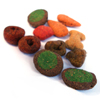
|
Artificial colourings

|
Particularly low grade, highly contentious or excessively vague ingredient we usually recommend avoiding
|
|
As any parent will testify, certain foods can have a dramatic effect on a child's behaviour. As early as the 1950's, artificial colourings were being linked with behavioural issues amongst other health problems in people and several recent scientific trials have shown a clear link between food additives and ADD (attention deficit disorder) and hyperactivity in children. Unfortunately, the effects of these ingredients seem to be exactly the same for our dogs with reduced attention spans and hyperactivity regularly reported.
Common artificial colourings found in dog foods include sunset yellow, tartrazine, ponceau 4r, patent blue V and titanium dioxide, although they may also be listed by their E numbers or simply as 'colourings'. They are often derived from petroleum products and often persist in the environment for many years or even decades.
It is also worth mentioning that most studies indicate that dogs are largely colourblind so the only role of the colourings is to appeal to the owner and not to the dog.
Find foods containing Artificial colourings
Go back to top
|
|
|
Artificial flavourings

|
Inferior or controversial ingredient
|
|
Many pet foods are listed as "free from artificial flavours". Actually, artificial flavours are rarely used in pet foods since their natural counterparts (fats, digest, sugars etc.) are both cheap and effective.
Nevertheless, a number of artificial flavours have found their way into the pet food market. Smoke and bacon flavours are fairly popular in some brands of treats and a few foods also incorporate liquid artificial meat flavours. Whether this is to provide a better taste for the dog or a more appealing smell for the owner is questionable.
Synthetic flavours, like many other artificial additives, have been linked to averse reactions in people and animals and since there's really no good reason for their use in pet food, we recommend steering well clear.
Find foods containing Artificial flavourings
Go back to top
|
|
|
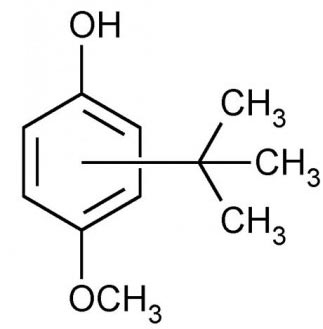
|
Artificial preservatives and antioxidants

|
Particularly low grade, highly contentious or excessively vague ingredient we usually recommend avoiding
|
|
A preservative is any ingredient added to a food to slow down spoilage. The preservatives used in pet foods can be grouped into two general types: antimicrobials that block growth of bacteria, moulds or yeasts and antioxidants that slow the oxidation of fats and lipids that leads to rancidity.
Both preservatives and antioxidants can come from natural sources (such as vitamin E and rosemary oil) or be artificially created. Here we will talk only about artificial preservatives and antioxidants. To find out more about natural preservatives and antioxidants in pet food, click here.
Artificial preservatives and antioxidants are far more widespread in pet food than most people imagine and although they certainly work at slowing down decomposition (in some cases giving pet foods a shelf life of over four years!), there are a whole host of concerns regarding their effects on health.
BHA (butylated hydroxyanisole or E320) and BHT (butylated hydroxytoluene or E321) are amongst the most common artificial antioxidants used in pet foods and are particularly worrying. One study at the University of Hamburg concluded that "all published findings agree with the fact that BHA and BHT are tumour promoters"[1] and the Department of Health and Human Studies in the US found that BHA consistently produces tumours in both rats and fish [2]. And the potential side-effects aren't just physical with one study finding a whole host of behavioural problems including increased aggression and "a severe deficit in learning" linked to BHA and BHT consumption in mice [3]. Despite all of the evidence, both BHA and BHT are currently permitted in pet food (and human food) in both the US and in Europe.
Propyl Gallate (E310), an artificial preservative that is often used in conjunction with BHA and BHT, has also been linked with tumour formation in rats [4].
Another common preservative, Potassium Sorbate (E202) is listed as a skin, eye and respiratory irritant, has been shown to damage white blood cells and may also contribute to tumour formation [5].
One piece of good news for European pet owners is that Ethoxyquin or E324 (which was once one of the most widespread artificial antioxidants in pet foods and has a long history of connections with allergic reactions, skin disease, behaviour problems and far worse conditions) was 'suspended' by the European Food Safety Authority in April 2017 on the basis that it may cause damage to DNA and lead to cell mutation [6]. This is, however, just a suspension and not a ban meaning that it could well return in time. Ethoxyquin is still widely used outside of the EU.
As you can see, chemical preservatives include some of the most controversial additives around and since there are good natural alternatives, there really is no justification for their continued use in pet foods.
How to avoid artificial preservatives and antioxidants
Unfortunately, avoiding artificial preservatives and antioxidants isn't easy. Over the years manufacturers have found more and more ways to hide their use of these highly contentious ingredients.
Look beyond the ingredients list
When a pet food manufacturer adds preservatives to its products, they have to be declared on the label. Oddly, though, they don't necessarily have to be listed alongside the other ingredients and can instead be buried within the typical analysis or elsewhere in the 'statutory statement' (the area on the label with all of the legally required info like ingredients, typical analysis, best before date etc) so you do need to keep your eyes peeled.
Word games
Terminology on ingredients list is somewhat of an art form. The law does provide rules for how ingredients should be listed but there is still plenty of wiggle room for manufacturers to add some spin here and there. So rather than simply stating that a food is, for example, 'preserved with BHA, BHT and propyl gallate', which might put off customers, they are much more likely to use far less worrying phrases like 'contains EU permitted antioxidants'. In fact, for some dog owners I have spoken to, 'EU permitted antioxidants' actually conjures images of the kind of good, natural antioxidants that have recently become popular for humans like goji berries and fresh blueberries. As we have established above, when you see antioxidants listed on a pet food and it is not accompanied by the word natural, it is not referring to anything good.

Let's play spot the artificial preservatives!
"No added preservatives"
Unfortunately, even if you find a food with no mention of artificial preservatives or antioxidants anywhere on the label, that's still not a guarantee that the food is free from them.
The sad truth is that it is actually impossible to say from the packaging alone whether some foods might contain artificial preservatives or not. This is because, while additives added by the manufacturers themselves have to be declared on the packaging, there is a legal loophole allowing artificial additives that were added to the ingredients before they reached the pet food factory to go undeclared. In fact, even if a food is littered with ingredients that have been individually treated with artificial preservatives before reaching the factory, the manufacturer can still legally claim that the food has 'no added preservatives' as they technically didn't add any!
Meat meal is a particular problem in this respect as it routinely has artificial preservatives added before it reaches the pet food factories - a fact that very few manufacturers manage to communicate to their customers.
So the only way to be 100% sure if your pet food is completely free from artificial preservatives and antioxidants (including any added by their ingredient suppliers) is to look for foods clearly labelled as free from artificial preservatives or to ask the manufacturer directly.
References
- Toxicology of the synthetic antioxidants BHA and BHT in comparison with the natural antioxidant vitamin E, University of Hamburg, 1993. https://www.ncbi.nlm.nih.gov/pubmed/8493816
- Report on Carcinogens, Fourteenth Edition - Butylated Hydroxyanisole, National Toxicity Program, U.S. Department of Health and Human Studies, 2016. https://ntp.niehs.nih.gov/ntp/roc/content/profiles/butylatedhydroxyanisole.pdf
- The effect of butylated hydroxyanisole and butylated hydroxytoluene on behavioral development of mice, Loyola University, Illinois, 1974. http://www.feingold.org/Research/stokes.html
- Carcinogenesis bioassay of propyl gallate, U.S. Department of Health and Human Services, 1981. https://ntp.niehs.nih.gov/ntp/htdocs/lt_rpts/tr240.pdf
- Does potassium sorbate induce genotoxic or mutagenic effects in lymphocytes?, Toxicology in Vitro, 2009. http://www.sciencedirect.com/science/article/pii/S0887233309003853?via%3Dihub
- Commission Implementing Regulation (EU) 2017/962, 2017. http://eur-lex.europa.eu/legal-content/EN/TXT/?uri=uriserv%3AOJ.L_.2017.145.01.0013.01.ENG
Find foods containing Artificial preservatives and antioxidants
Go back to top
|
|
|
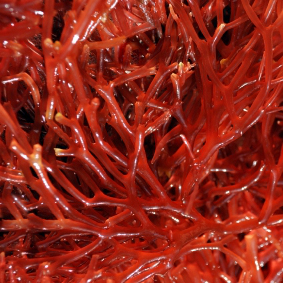
|
Carrageenan

|
Inferior or controversial ingredient
|
|
Carrageenans (E407) are a group of long, flexible polysaccharide chains (a type of carbohydrate) that are extracted from red edible seaweeds and have been used as a food additive for hundreds of years.
Its curling, helical structures allows carrageenan to form a gel at room temperature which has led to its widespread use as a gelling agent in both the human and pet food industries. In human food, carrageenan can be found in all sorts of foods from soy milk and yogurt to ready-meals and deli meats. In pet food, carrageenan is generally only found in firm wet foods like patés and 'loaf' foods.
Usage
Carrageenan is used as a gelling agent to give paté and loaf type wet pet foods their characteristic firm consistency. While there are a number of alternative gelling agents (agar-agar, konjac and alginate), carrageenan is by far the most popular amongst wet pet food producers.
Carrageenan is often used in conjunction with thickeners like cassia gum, guar gum or locust bean gum. These thickeners enhance the strength of gelling agents like carrageenan.
Safety
Despite its widespread use and long heritage, carrageenan has attracted considerable criticism from certain quarters of the scientific community.
A number of studies [1][2][3] have linked food grade carrageenan (also known as un-degraded carrageenan or just CGN) to gastrointestinal inflammation as well as higher rates of intestinal lesions, ulcerations, and even tumours. Degraded carrageenan (sometimes called poligeenan or dCGN), though, is far more potent. It is a known carcinogen and is routinely used to induce inflammation in lab animals so that scientists can test anti-inflammation drugs. While degraded carrageenan is not permitted in pet food, there is concern that some food grade carrageenan may be contaminated with dCGN [4] and also that the acid environment of the stomach may degrade food-grade carrageenan to form dCGN [1].
HOWEVER, for every study suggesting carrageenan could be problematic, there is another indicating that it is perfectly safe. Although many of the more pro-carrageenan studies are funded by and in many cases directly carried but by carrageenan producers (Celtic Colloids, FMC) or their affiliates (Toxpertise, Iontox), they are still subject to peer review and not without merit. In particular, a comprehensive review carried out in 2014 concluded that no studies to date had adequately demonstrated any carcinogenic, tumour promoter, genotoxic, developmental or reproductive effects from consuming food grade carrageenan [5][6].
Most significantly, in 2018 the European Food Safety Authority carried out its own investigation into carrageenan and found no adverse effects from carrageenan in rats all the way up to 7,500 mg/kg of body weight per day, which is WAY more than is found in pet foods and was the highest dose tested [7]. They did, however, express some uncertainties over the general lack of reliable information on the additive's effects and suggested more work was necessary before they could be 100% sure of its safety.
Which foods contain carrageenan?
As mentioned above, carrageenan is generally only used in paté and loaf type wet pet foods.
Unfortunately, without your own lab, figuring out whether any specific paté or loaf food contains carrageenan can be very difficult.
Firstly, since it is a technological additive and only needs to be added in very small amounts, carrageenan does not have to be declared by the manufacturer so just because it is not on the label does not mean it's not in the food. The manufacturer is also under no obligation to tell you, even if you ask them directly.
Secondly, the pet food company itself might not even know that its foods contain carrageenan. This is because many wet food producers outsource their manufacturing to third party factories who may add carrageenan (most often as a component of the vitamin and mineral premix) without specifically notifying the producer. Some factories even actively withhold information like this from their client companies.
We have tried to find out which paté and loaf wet foods do and do not contain carrageenan and we have added each brand's response to its product review pages. Where the information was not forthcoming, we have added the phrase 'not guaranteed carrageenan free by the manufacturer'. Unfortunately, though, we have the same problems in verifying this information as anyone else so while we can pass on their responses in good faith, we cannot guarantee their veracity.
Our advice
Carrageenan is certainly not the worst additive in pet food and for most dogs, the very small amount used is not likely to cause any upsets at all but we do still think caution is warranted. If your dog has a history of digestive upsets, it may well be best to look for a food that is free from carrageenan and other similarly controversial ingredients. Changing the diet up every so often would also help to limit the chances of carrageenan or any associated issues from building up in the dog's system over time.
If you do decide to avoid carrageenan, due to the total lack of transparency over its usage, the only way to be 100% sure would be to steer clear of firm wet foods like patés and loaf foods altogether.
References
-
Review of Harmful Gastrointestinal Effects of Carrageenan in Animal Experiments. Tobacman JK. Environmental Health Perspectives 109(10): 983-994. 2001. https://www.ncbi.nlm.nih.gov/pmc/articles/PMC1242073/
-
Exposure to common food additive carrageenan leads to reduced sulfatase activity and increase in sulfated glycosaminoglycans in human epithelial cells. Yang B, Bhattacharyya S, Linhardt R and Tobacman JK. Biochimie 94(6): 1309-16. 2012. https://www.ncbi.nlm.nih.gov/pubmed/22410212
-
Exposure to the common food additive carrageenan leads to glucose intolerance, insulin resistance and inhibition of insulin signalling in HepG2 cells and C57BL/6J mice. Bhattacharyya S, O-Sullivan I, Katyal S, Unterman T and Tobacman JK. Diabetologia 55(1): 194-203. 2012. https://www.ncbi.nlm.nih.gov/pubmed/22011715
-
Molecular weight distribution of carrageenans studied by a combined gel permeation/inductively coupled plasma (GPC/ICP) method. Yoshitaka Uno, Toshio Omoto, Yasunori Goto. Food Additives & Contaminants. 2010. https://www.tandfonline.com/doi/abs/10.1080/02652030117235
-
Food additive carrageenan: Part I: A critical review of carrageenan in vitro studies, potential pitfalls, and implications for human health and safety. McKim JM. Critical Reviews in Toxicology 44(3): 211-43. 2014. https://www.ncbi.nlm.nih.gov/pubmed/24456237
-
Food additive carrageenan: Part II: A critical review of carrageenan in vivo safety studies. Weiner ML. Critical Reviews in Toxicology 44(3): 244-69. 2014. https://www.ncbi.nlm.nih.gov/pubmed/24467586
-
Re‐evaluation of carrageenan (E 407) and processed Eucheuma seaweed (E 407a) as food additives. EFSA Panel on Food Additives and Nutrient Sources added to Food (ANS). EFSA Journal. 2018. https://efsa.onlinelibrary.wiley.com/doi/full/10.2903/j.efsa.2018.5238
Find foods containing Carrageenan
Go back to top
|
|
|
Cassia gum

|
Inferior or controversial ingredient
|
|
Cassia gum (E427 in human food, E499 in pet food) is widely used as a thickener in wet pet foods to enhance the strength of gelling agents. It is made from the seeds of the senna (also known as cassia) plant
Controversy
Cassia gum is probably the most controversial of the various thickeners used in pet food. It is regarded as a skin and respiratory sensitiser and as a potential irritant to skin and eyes [1] and has been found to be mutagenic to bacteria [2]. Despite these facts and the fact that the European Food Safety Authority has been "unable to establish its safety for cats and dogs" [2], cassia gum is somehow still allowed in pet food, although its inclusion must at least be declared on the label (be sure to also check the 'technological additives' section of the label).
According to our sources in wet pet food manufacturing, cassia gum is only ever used in conjunction with gelling agents, some of which are also controversial and do not need to be declared on the label.
As far as we're concerned, the potential risks of cassia gum far outweigh the benefits, so we would recommend giving it a wide berth.
Find foods containing Cassia gum
Go back to top
|
|
|

|
EC permitted additives

|
Particularly low grade, highly contentious or excessively vague ingredient we usually recommend avoiding
|
|
The EU has listed over 4000 artificial additives which may be added to foods and 'EU permitted additives' covers them all. Although many are harmless or even beneficial, it also includes chemical flavourings and colourings (many of which have been linked to behavioural problems and other health concerns) and artificial preservatives like BHA and BHT which have been identified as possible causes of cancer. For many nutritionists, 'EU permitted additives' is the number one ingredient to avoid.
Find foods containing EC permitted additives
Go back to top
|
|
|
Gelling agents and thickeners

|
Inferior or controversial ingredient
|
|
 Some types of wet pet food and most notably paté / loaf type foods require special additives known as thickeners and gelling agents in order to bind the ingredients and allow the food to maintain its firm consistency.
Some types of wet pet food and most notably paté / loaf type foods require special additives known as thickeners and gelling agents in order to bind the ingredients and allow the food to maintain its firm consistency.
While the inclusion of some thickeners and gelling agents must be declared on the pet food label, many can be used without any declaration. This can be extremely problematic for some pet owners as several thickeners and gelling agents have been linked to adverse reactions and ill health in pets.
For more information on why finding out what gelling agents and thickeners a dog food contains is so difficult, check out our post here.
Gelling agents
When added to water, gelling agents, which are typically powders, dislove to create a gel like structure. All paté and loaf type foods contain some form of gelling agent.
Currently, the most common gelling agents available to pet food producers include:
Thickeners
Thickeners are often used in conjunction with one of the above gelling agents in order to enhance gelling strength.
According to our sources, these thickeners serve absolutely no purpose in a food unless one of the above gelling agents is also present so if you see them on a wet pet food label without an associated gelling agent, it's reasonable to assume one or more undisclosed gelling agents are also present.
Find foods containing Gelling agents and thickeners
Go back to top
|
|
|
Guar gum

|
Medium quality ingredient - nutritionally adequate and unlikely to cause any problems e.g. fillers etc
|
|
Guar gum (E412) is a thickener extracted from guar beans. It is essentially a flour that is often used in conjunction with gelling agents to enhance their gelling strength.
Guar gum is certainly a lot less contentious than the alternative cassia gum but it is not entirely without controversy with some studies suggesting that it may reduce the digestibility of the rest of the food and particularly the protein [1].
It's also important to note that according to our sources in wet pet food manufacturing, thickeners like guar gum are only ever used with gelling agents, some of which are somewhat controversial and do not need to be declared on the label. If in doubt, ask your wet food manufacturer what gelling agents they use directly.
Find foods containing Guar gum
Go back to top
|
|
|
Konjac

|
Medium quality ingredient - nutritionally adequate and unlikely to cause any problems e.g. fillers etc
|
|
Konjac (E425) powder is a strong gelling agent made from the fibre root of the konjac plant. It is widely used in human food and is becoming increasingly popular in the wet pet food industry as a less contentious alternative to carrageenan. Like carrageenan, it helps to bind the ingredients of paté type wet foods to provide their characteristic firm texture.
Although studies on the safety of konjac for pets are few and far between, especially when fed for extended periods, one study showed that some people eating 3 grams of konjac per day began to experience abdominal discomfort, diarrhoea and constipation after 12 weeks [1]. This led the European Food Safety Authority to recommend a maximum total daily intake of konjac for people of 3g per day - around 40 mg of konjac per kilo of body weight per day. With no recommended daily dose figures for pets, this is currently the best rule of thumb we have.
One study [2] also suggested that konjac may interfere with vitamin E and cholesterol absorption.
While konjac is certainly less contentious than some alternative gelling agents, its safety is not 100% assured. For that reason, if your dog is experiencing unexplained digestive problems on a food containing konjac, it may be worth trialling an alternative that doesn't contain the ingredient.
Find foods containing Konjac
Go back to top
|
|
|
Locust bean gum / carob gum

|
Medium quality ingredient - nutritionally adequate and unlikely to cause any problems e.g. fillers etc
|
|
Locust bean gum (or carob gum as it is also known) is a thickener extracted from the seeds of the carob tree. It is used in conjunction with gelling agents to enhance their gelling strength.
Compared to some of the other thickeners out there, locust bean gum appears to be one of the safest with several authorities verifying its safety over the years [1].
Note, though, that according to our sources in wet pet food manufacturing, thickeners like locust bean gum are only ever used with gelling agents, some of which are somewhat controversial and do not need to be declared on the label. If in doubt, ask your wet food manufacturer what gelling agents they use directly.
Find foods containing Locust bean gum / carob gum
Go back to top
|
|
|
Natural colourings

|
Medium quality ingredient - nutritionally adequate and unlikely to cause any problems e.g. fillers etc
|
|
Despite the fact that numerous studies have indicated that dogs are largely colourblind, many manufacturers feel the need to add colours to their foods. Although many pet food manufacturers still use artificial colours, more and more are turning to natural alternatives as the anti-additives movement gains ground.
Natural colours are much less vibrant than their synthetic counterparts and are much more sensitive to environmental conditions like heat, light and pH. Common natural colorants include beetroot, caramel, paprika, grape and turmeric and although none are at all harmful to dogs, they also aren't at all beneficial.
Find foods containing Natural colourings
Go back to top
|
|
|
Natural preservatives and antioxidants

|
Good quality ingredient with beneficial nutrients
|
|
A preservative is any ingredient added to a food to slow down spoilage. Antioxidants are an important branch of preservatives as they inhibit the oxidisation process which turns fats rancid. Virtually all dry foods contain some form of preservatives. Some continue to use highly controversial artificial preservatives but increasingly, manufacturers are turning to natural alternatives.
The most common natural preservatives are vitamin E (often labelled as mixed tochopherols), vitamin C (ascorbic acid) and rosemary oil, all of which are able to dramatically slow down the rate at which fats go rancid. Of course, natural preservatives will never be as efficient as their artificial counterparts but most naturally preserved dry foods still maintain a shelf life of 12 months.
Find foods containing Natural preservatives and antioxidants
Go back to top
|
|
|
Phosphoric Acid

|
Inferior or controversial ingredient
|
|
Phosphoric acid (E338) is a clear, colourless liquid that is added to foods primarily as an acidifier but is also used effectively as a flavouring, emulsifier and to prevent discolouration. It is best known as an additive in cola drinks.
Studies have linked phosphoric acid to reduced bone density in humans making it a fairly controversial ingredient for both people and dogs. Although more work is necessary to confirm the link, we would recommend playing it safe in the meantime and steering clear of foods with high levels of phosphoric acid.
Find foods containing Phosphoric Acid
Go back to top
|
|
|
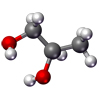
|
Propylene glycol

|
Inferior or controversial ingredient
|
|
Propylene glycol is a synthetic compound that absorbs water and can therefore be used to keep semi-moist dog foods and treats semi-moist. It also has anti-bacterial and anti-fungal properties making it suitable as a preservative.
Although propylene glycol has been approved as safe for both humans and dogs (but not cats due to its links to the feline condition Heinz body anaemia), it remains a source of controversy. This is partly due to regular links to asthma and allergic reactions and partly because propylene glycol's other commercial uses (including car antifreeze and in de-icing aircraft) don't inspire too much confidence in dog owners.
Find foods containing Propylene glycol
Go back to top
|
|
|
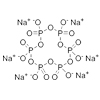
|
Sodium hexametaphosphate

|
Medium quality ingredient - nutritionally adequate and unlikely to cause any problems e.g. fillers etc
|
|
Sodium hexametaphosphate (also known as sodium HMP or E452i) is added to some dog foods because of its effect of softening and reducing tooth tartar.
Although consuming large amounts is not recommended, the kind of concentrations found in pet foods are regarded as safe.
Find foods containing Sodium hexametaphosphate
Go back to top
|
|
|
Sodium Tripolyphosphate (STPP)

|
Inferior or controversial ingredient
|
|
Sodium Tripolyphosphate (also called STPP or E451) is added to dog foods as a preservative and to help moist foods to retain moisture so that they appear fresher for longer.
Although STPP is generally recognised as safe, it has been listed by the US National Institute for Occupational Safety and Health as a possible neurotoxin and is widely recognised as a mild skin irritant. We therefore recommend steering clear of foods containing STPP, especially if your dog is prone to skin problems.
Find foods containing Sodium Tripolyphosphate (STPP)
Go back to top
|
|
|
Tocopherols

|
Good quality ingredient with beneficial nutrients
|
|
Tocopherols (part of the vitamin E family of compounds) are powerful antioxidants and are the most commonly used natural preservative in dog food. As antioxidants, tochopherols are able to slow down the spoilage of food by inhibiting the oxidisation that turns fats rancid. Their use is extremely widespread in the UK as it provides a convenient, healthy alternative to potentially harmful chemical preservatives.
Find foods containing Tocopherols
Go back to top
|
|
|
Other ingredients
|
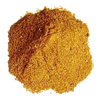
|
Brewer's Yeast

|
Good quality ingredient with beneficial nutrients
|
|
Brewer's yeast is one of the best sources of natural B vitamins including B1 (thiamine), B2 (riboflavin), B3 (niacin), B5 (pantothenic acid), B6 (pyridoxine), B7 (biotin) and B9 (folic acid). These vitamins have a wide range of functions in dogs including aiding digestion, supporting of the nervous system and keeping the skin, hair, eyes, mouth, and liver healthy.
Yeast is also a good source of protein. It is known as a 'complete protein' since it contains all nine of the essential amino acids needed by dogs.
Find foods containing Brewer's Yeast
Go back to top
|
|
|
Cellulose

|
Inferior or controversial ingredient
|
|
In food, cellulose is the scientific term for dietary fibre. It can be found in the cell walls of all plants and is almost entirely indigestible for dogs which is actually a very good thing as its undigested form provides a wide range of benefits.
However, while cellulose per-se is good for dogs, it's usually not a great thing to see it listed as an ingredient. This is because pure cellulose or lignocellulose powder is quite different from the fibre found in whole fruit and veg. It is a white, odourless powder that is most often produced as a low value byproduct of agriculture (e.g. corn stover, sugarcane bagasse, straw) or as waste material from saw mills and paper mills (it really is!).
Cellulose is most often found in light diets since it helps to bulk out the diet whilst providing almost zero calories.
As fibre supplements go, cellulose powder is probably the most controversial and many nutritionists recommend avoiding it altogether.
Find foods containing Cellulose
Go back to top
|
|
|
Charcoal

|
Medium quality ingredient - nutritionally adequate and unlikely to cause any problems e.g. fillers etc
|
|
Charcoal absorbs excess gas and is often recommended for relieving wind and bloating in dogs. Unlike charcoal for barbeques, the edible form must be 'activated' with high temperatures and steam before it can be eaten. Activated charcoal can come from a number of sources including wood, coconut shells, peat and bamboo.
Find foods containing Charcoal
Go back to top
|
|
|
Diatomaceous earth

|
Medium quality ingredient - nutritionally adequate and unlikely to cause any problems e.g. fillers etc
|
|
Diatomaceous earth (also labelled as diatomite or siliceous earth or by its German name, kieselgur) is a form of soft, highly porous, sedimentary rock made from the fossilised remains of diatoms, a type of hard-shelled algae. In dog food it performs a similar function to charcoal in absorbing toxins in the gut and reducing the incidence of wind. It is also mildly abrasive so it may also help to remove tooth plaque.
Find foods containing Diatomaceous earth
Go back to top
|
|
|
Glycerin

|
Medium quality ingredient - nutritionally adequate and unlikely to cause any problems e.g. fillers etc
|
|
Glycerin, glycerine, glycerol and E422 all refer to the compound, propane-1,2,3-triol. It is found throughout nature as an essential part of tri-glyceride fats. It is not, however, found on its own which has led some more ardent natural feeding advocates to label isolated glycerin as 'unnatural'. Pure glycerin is non-toxic and is generally regarded as safe. It is generally produced as a byproduct of soap manufacture and it has found a wide range of applications in the food and cosmetic industries. It is regularly found in pet foods (especially treats) as a humectant - that is it helps keep foods moist without allowing the moisture to speed up the food's decomposition. It also has a sweet taste which makes any foods it is added to more appealing to dogs.
Find foods containing Glycerin
Go back to top
|
|
|
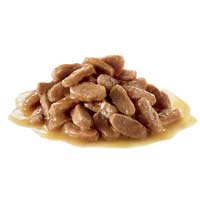
|
Gravy / sauce

|
Medium quality ingredient - nutritionally adequate and unlikely to cause any problems e.g. fillers etc
|
|
Gravy (or sauce) in pet food is an ill-defined and poorly regulated term.
While it may refer to actual gravy, as you or I would understand it (a separately formulated sauce of meat fat and juices with stock and seasoning), it can equally be used for little more than water made to look a little like gravy with colourings and thickeners or anything in-between.
When gravy is listed without a breakdown of its sub-components, it can also be used as a vehicle for adding other, less marketable ingredients like salt, digest or additives to a food without them having to be declared.
In dry foods, the term gravy can also refer to a natural flavouring that is sprayed on to the biscuits at the end of manufacturing. In this case it is usually made up of a combination of meat (usually ) and oils.
If you are at all unsure about the ingredients of your dog food, it is always best to contact the manufacturer directly.
Find foods containing Gravy / sauce
Go back to top
|
|
|
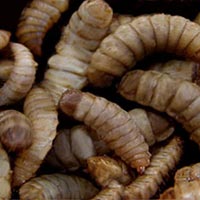
|
Insect Meal

|
Good quality ingredient with beneficial nutrients
|
|
As our regular visitors will know, we are fans of meat for our dogs. We thoroughly believe that it is the best source of nutrition for dogs and therefore we have always insisted that it should make up the core of any good dog food. But as you're no doubt aware, meat is also becoming a huge problem for the planet. As global demand for meat increases, the meat industry is responsible for ever increasing levels of habitat destruction (to clear land for meat animal rearing and for growing the crops that feed them) and carbon emissions that contribute to climate change. Add to that the awful animal welfare that most factory-farming entails and it's easy to see why meat alternatives are rapidly becoming one of the hottest topics in the pet food world.
Chief amongst the potential alternatives to meat in pet food are insects. There are currently a dozen or so candidates for insect protein sources including housefly pupae, crickets, mealworm larvae, black soldier fly larvae and cockroaches. They are all easy, quick and relatively inexpensive to produce with far lower carbon emissions or required space than conventional meat farming. Some, like the black soldier fly, can even be raised entirely on waste human food, making them an even better choice for the environment.
And while it might seem odd to feed your four legged friends on some six legged bugs, it's not actually all the weird at all. Right now, a whole host of human cultures across the world consume nearly 2000 species of insects on a daily basis and wild forms of both cats and dogs commonly eat insects as part of their day to day diets.
In terms of palatability, insects can be a bit of a mixed bag. Different species have entirely different flavours and a lot also depends on what the insects themselves have been fed on and how they have been cooked or otherwise prepared.
Insects for use in pet foods are generally dried and ground to form a powder called insect meal.
And the key question: is insect meal actually any good for our dogs? Well, although studies on insect derived nutrition for pets is still a little limited, the data that is available is actually very positive. Insect meal is typically very rich in protein (from 37 to 63% dry matter) and its amino acid profile generally scores very well for both cats and dogs, often roughly in line with fish meal and poultry meal. Again, the exact composition of amino acids and digestibility varies a lot from species to species and also depending on what the insects have eaten. For example, housefly pupae have a very high amino acid score and a digestibility just below that of poultry meal while yellow mealworms don't score quite as well for their amino acids but have a very high digestibility, above even that of poultry meal.
Of course, these comparisons are only with poultry meal and fish meal, both of which have plenty of their own critics. It is not known how insect meal compares with the 'fresh' meats used in dry pet foods nor with raw meats.
It is also worth noting that some insect meals, particularly that made from black soldier fly larvae (which is used in foods like Yora), contains relatively high levels of saturated fat which may not be ideal for all pets.
References
- Protein quality of insects as potential ingredients for dog and cat foods. Journal of Nutritional Science, 2014. Link
- Review of Black Soldier Fly (Hermetia illucens) as Animal Feed and Human Food. National Taiwan University, 2017. Link
Find foods containing Insect Meal
Go back to top
|
|
|
Natural flavourings

|
Medium quality ingredient - nutritionally adequate and unlikely to cause any problems e.g. fillers etc
|
|
The term natural flavouring can be used for any extract from any food whose significant function is flavouring rather than nutritional. This is clearly very broad and could refer to anything from herbs or meat meals to more questionable ingredients like digest.
In dry pet foods, natural flavourings sometimes refers to a combination of fresh meat and oils which is sprayed on to the food in the final stages of manufacturing.
If you are at all unsure about the ingredients of your dog food, it is always best to contact the manufacturer directly.
Find foods containing Natural flavourings
Go back to top
|
|
|

|
Oils and Fats

|
Particularly low grade, highly contentious or excessively vague ingredient we usually recommend avoiding
|
|
In nutritional terms, oils and fats are two words for the same thing. The broad term 'oils and fats' encompass all oils and fats from any plant or animal source.
Like all animals, dogs need a certain amount of fat from their diet to survive. Fat is found naturally in many types of foods but because dogs find fats so irresistible, extra is often added to dog foods. For fussy dogs it is often a good idea to look for foods with higher fat levels but be careful as too much fat can lead to the same kind of problems as in humans.
Umbrella terms like 'oils and fats' can make choosing the right food for your dog difficult as it gives very little indication of what is actually in the food. It could, for example, refer to beneficial oils or high quality animal fats, or it could be used for low grade, potentially harmful or highly processed oils.
Because it is impossible to know what oils or fats are included, we generally recommend assuming the worst and avoiding foods with this ingredient. This is particularly important if your dog is prone to dietary intolerance as identifying and eliminating problem ingredients is impossible unless you know exactly what you are feeding.
Find foods containing Oils and Fats
Go back to top
|
|
|

|
Salt

|
Inferior or controversial ingredient
|
|
Salt, or sodium chloride as it is often listed, is commonly added to pet foods as a flavour enhancer.
While salt is a necessary mineral, it is generally present in sufficient quantities in the raw ingredients of pet foods. However, since dogs, like humans, enjoy the taste of salt, extra is regularly added to dog foods to make them more appealing. Unfortunately, excessive salt has the same health implications for dogs as for us and should be avoided. This is particularly important if your dog has a history of heart problems or high blood pressure.
Find foods containing Salt
Go back to top
|
|
|
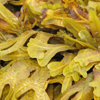
|
Seaweed

|
Good quality ingredient with beneficial nutrients
|
|
Seaweed is a popular nutritional supplement in natural dog foods. Although there are a wide variety of edible seaweeds, kelp is the most common one used in dog food.
Seaweed is a good source of a huge range of minerals including calcium, iron, magnesium and many more. They are also rich in the rare mineral iodine which is necessary for healthy thyroid function (please note that too much iodine can be harmful so large amounts of seaweed should be avoided).
Find foods containing Seaweed
Go back to top
|
|
|

|
Special ingredients

|
Particularly low grade, highly contentious or excessively vague ingredient we usually recommend avoiding
|
|
Legally, UK dog food producers are obliged to state roughly what is in their products. However, if divulging some of the ingredients is likely to result in a competitive disadvantage - for example, if it gives away a companies 'secret formula', this obligation can be waived.
The problem for dog owners is that terms like 'special ingredients' could refer to literally anything, which makes choosing the right food very difficult. As always, where ingredients are unclear, we would recommend assuming the worst and looking elsewhere.
Find foods containing Special ingredients
Go back to top
|
|
|
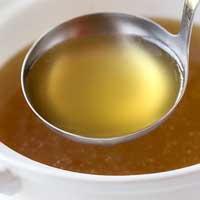
|
Stock / broth

|
Medium quality ingredient - nutritionally adequate and unlikely to cause any problems e.g. fillers etc
|
|
Stock or broth in pet food is another often-misleading term.
While it may refer to actual stock as you or I would understand it (meat, bones or vegetables simmered in water for an extended period of time possibly with herbs or other aromatics for flavour), 'stock' can and is used by some manufacturers to refer to water. Literally just water!
When listed in conjunction with a meat or vegetable (chicken broth or vegetable stock, for example) the ingredient should have some relation to that ingredient but monitoring and regulation is almost non-existent.
To make things worse, some manufacturers have started bracketing stock and broth ingredients with their meat ingredients, allowing them to make quite misleading claims like 'Chicken 50% (chicken meat 25%, chicken stock 25%)'.
If you are at all unsure about the ingredients of your dog food, it is always best to contact the manufacturer directly.
Find foods containing Stock / broth
Go back to top
|
|
|
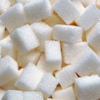
|
Sugars

|
Particularly low grade, highly contentious or excessively vague ingredient we usually recommend avoiding
|
|
Sugars are added to dog foods because dogs, like humans, like them. They can come be listed in a number of ways (sugar, caramel, syrup, sucrose etc.) and can come from a wide range of sources (corn/maize, wheat, sugar cane, sugar beet etc.). Unfortunately, too much sugar can have the same effects in dogs as it does in people. High sugar diets have been linked to hyperactivity, hypoglycemia, obesity and tooth decay amongst other conditions and should therefore be avoided.
Find foods containing Sugars
Go back to top
|
|
|
|
Advertisement
|